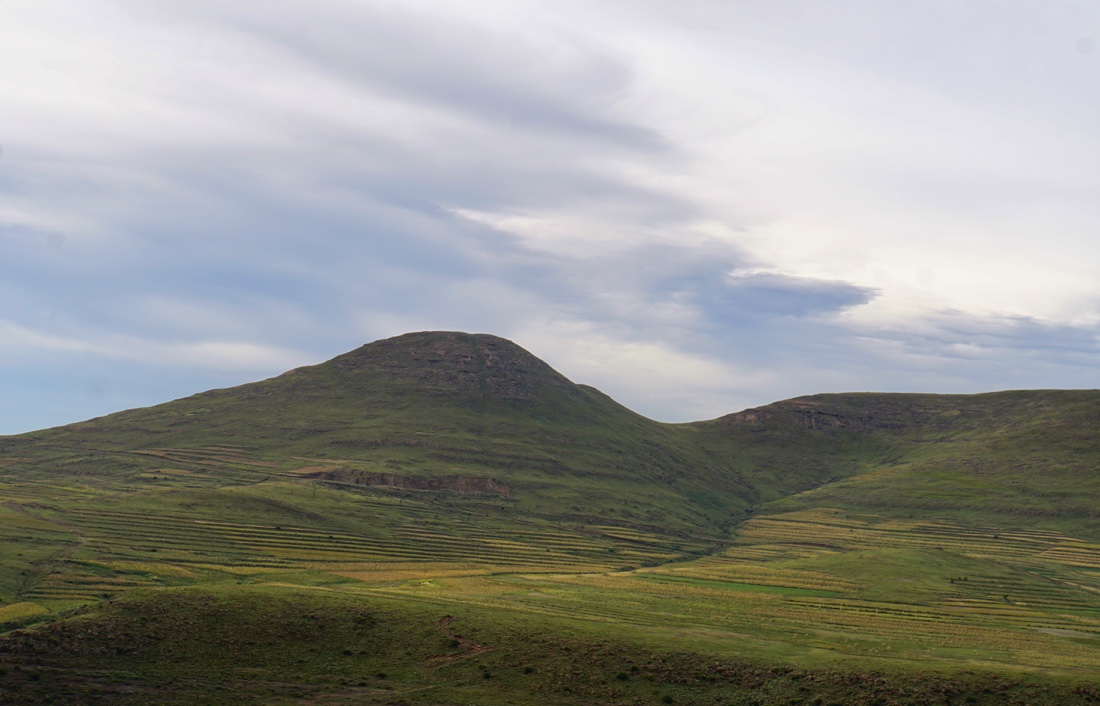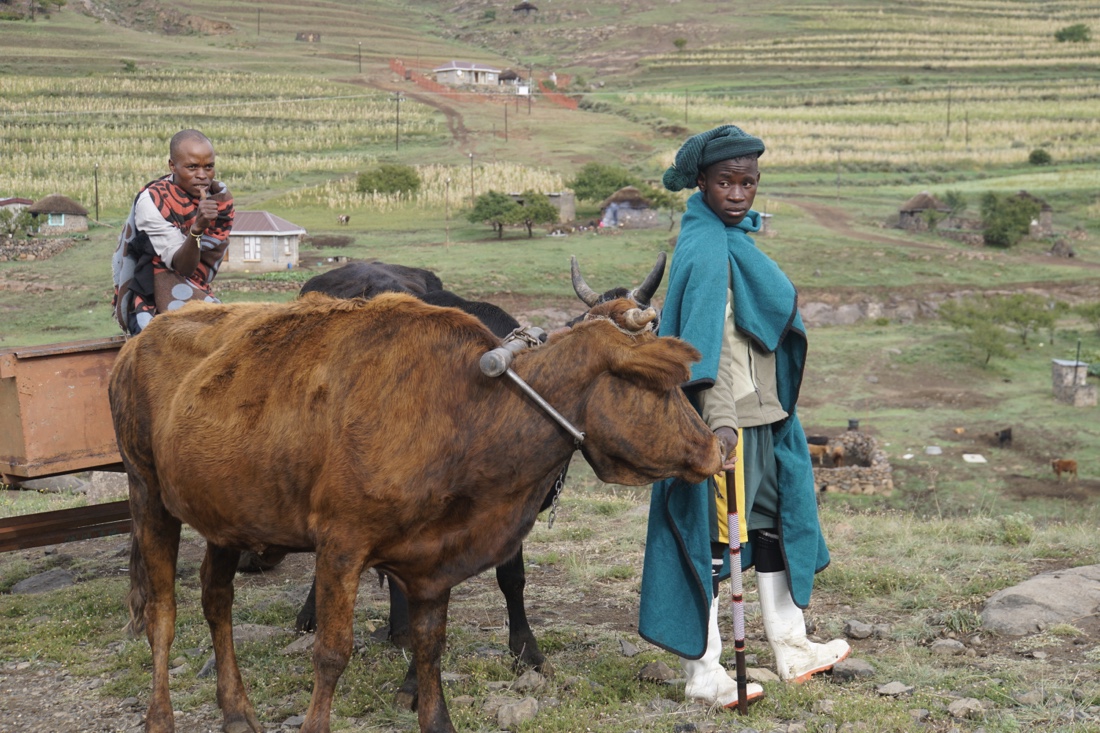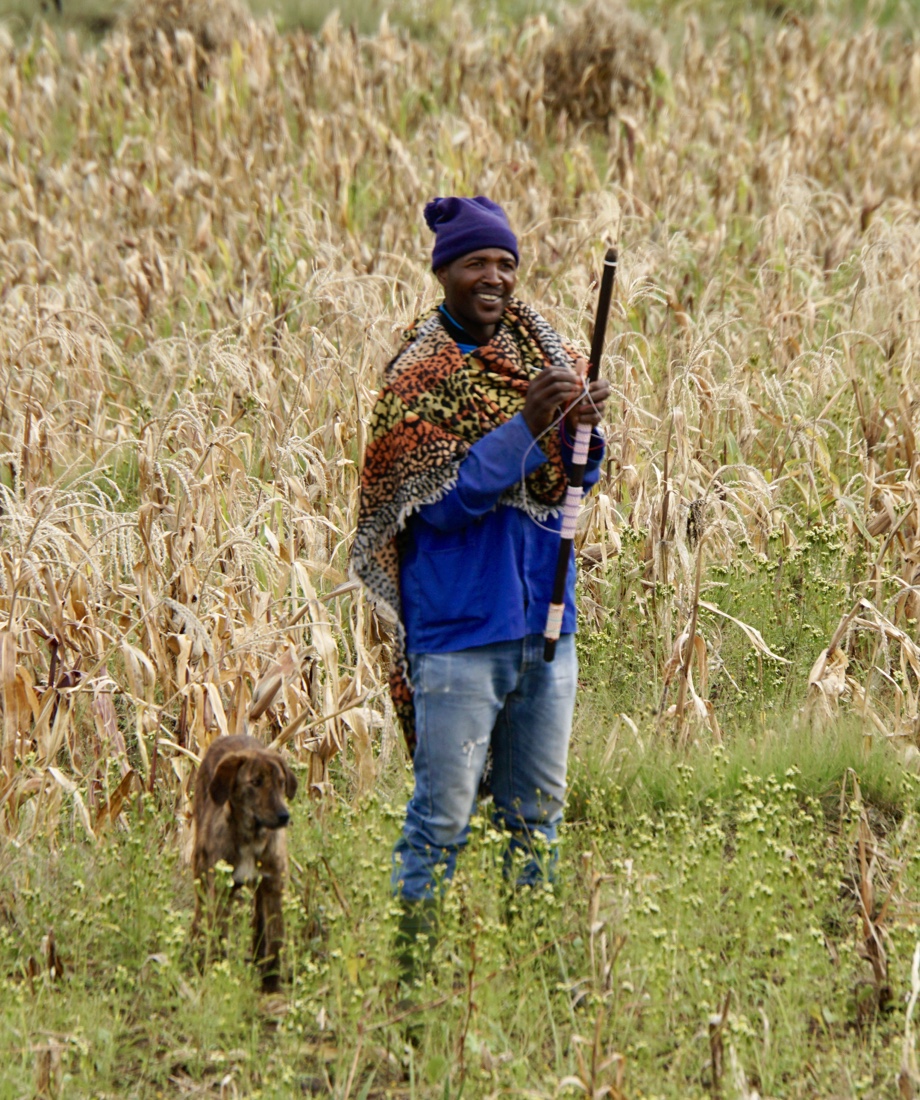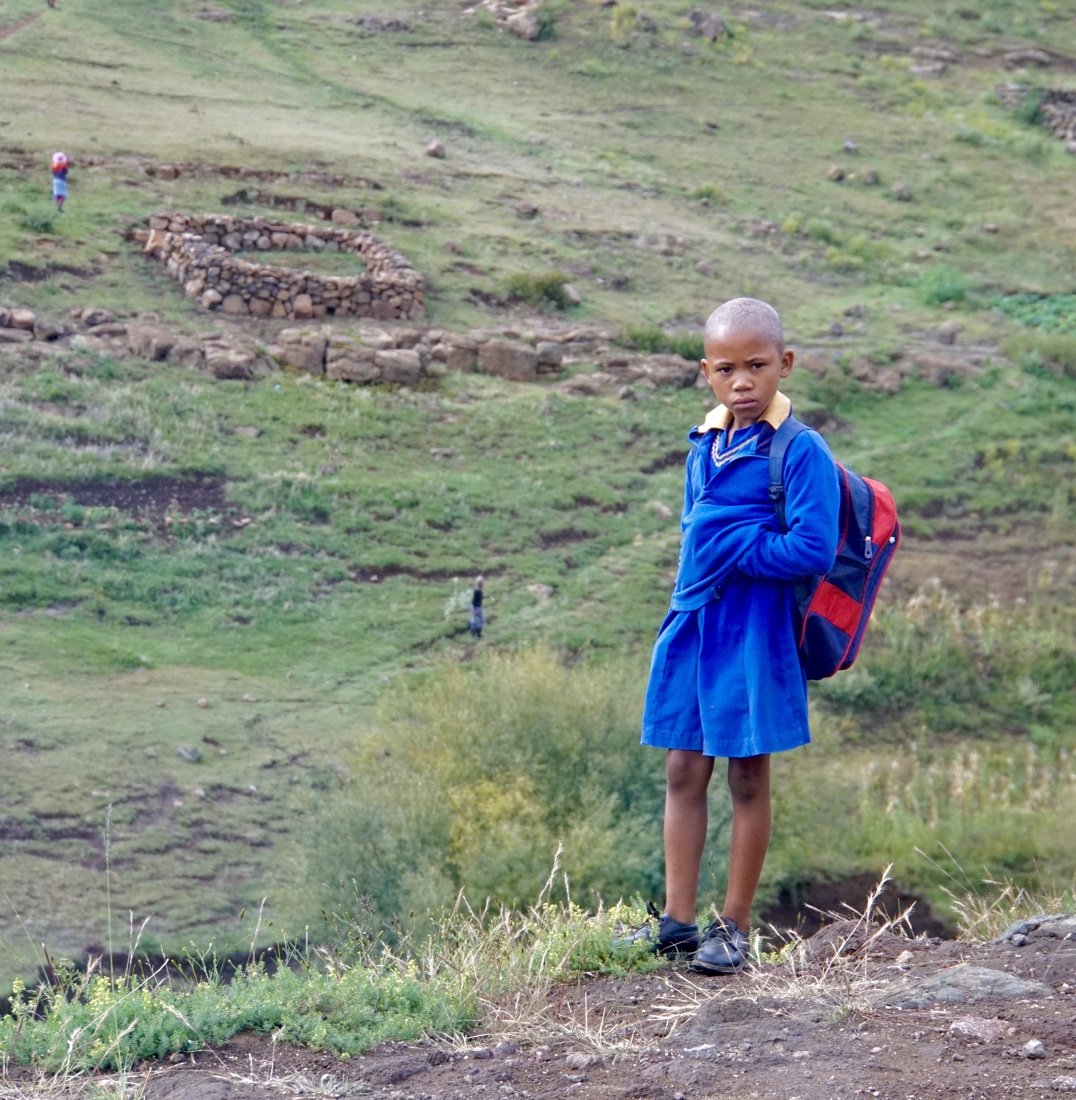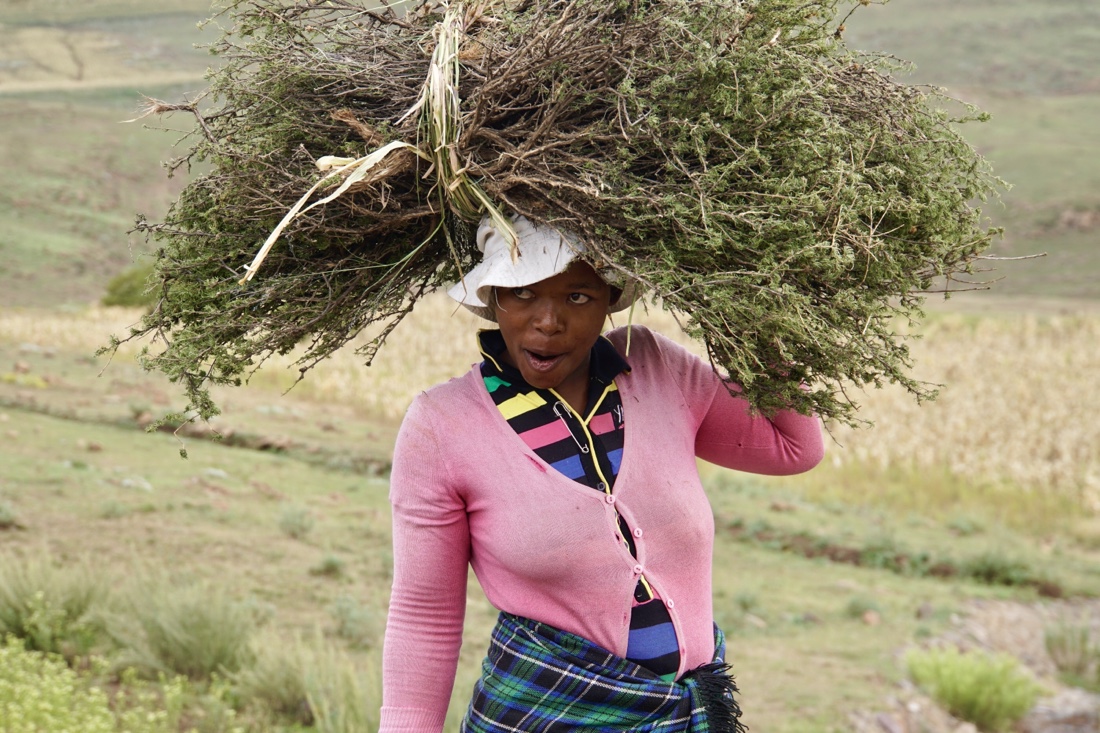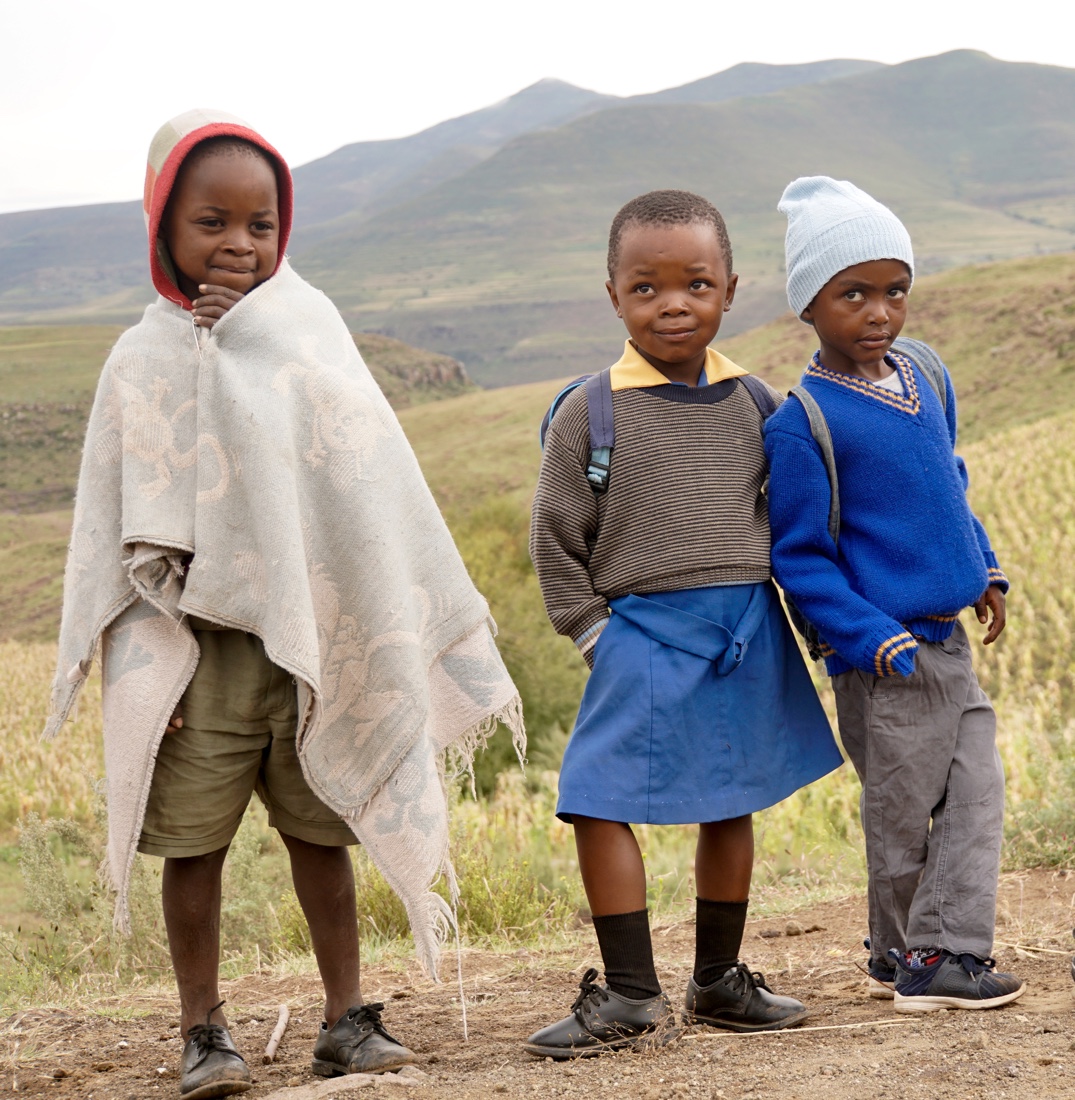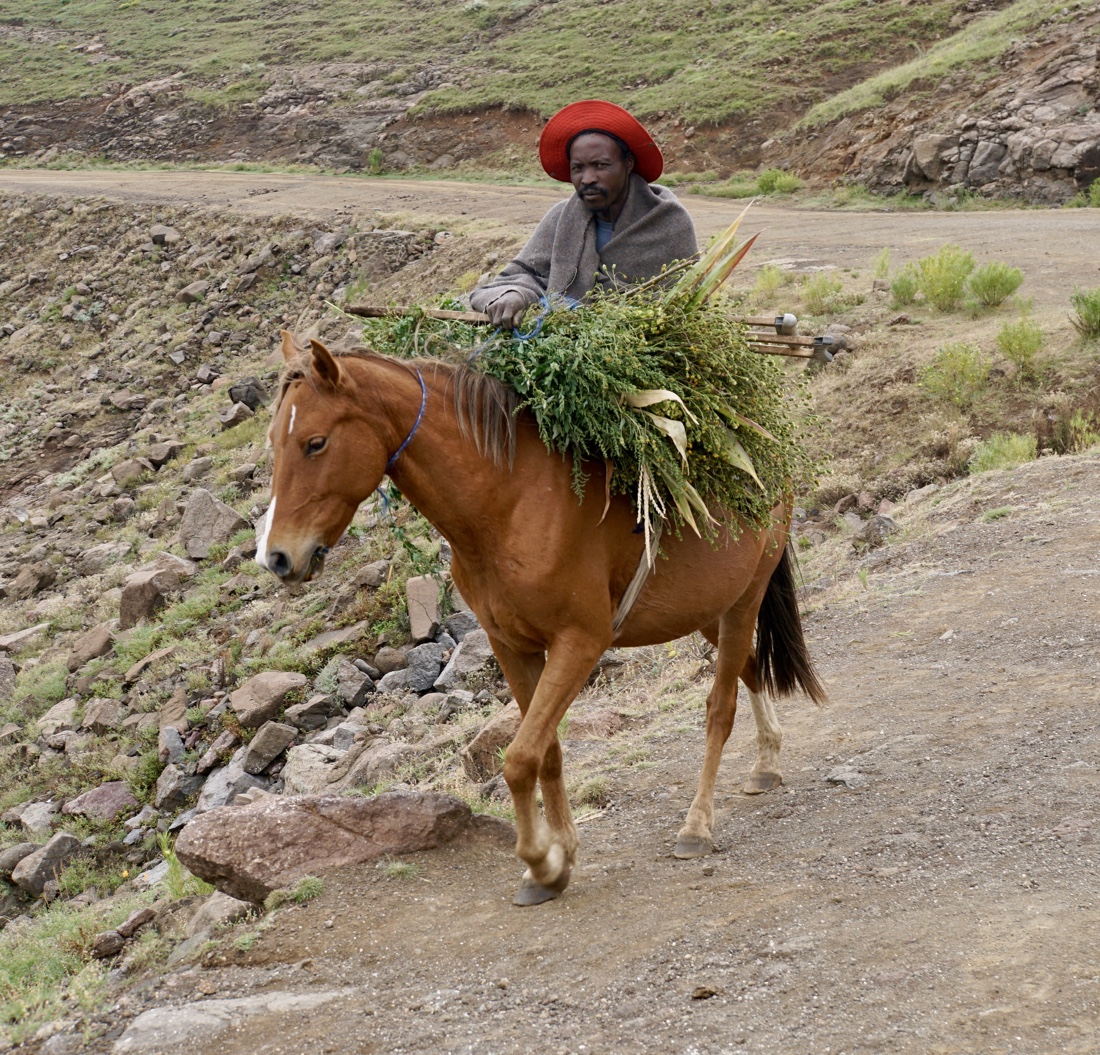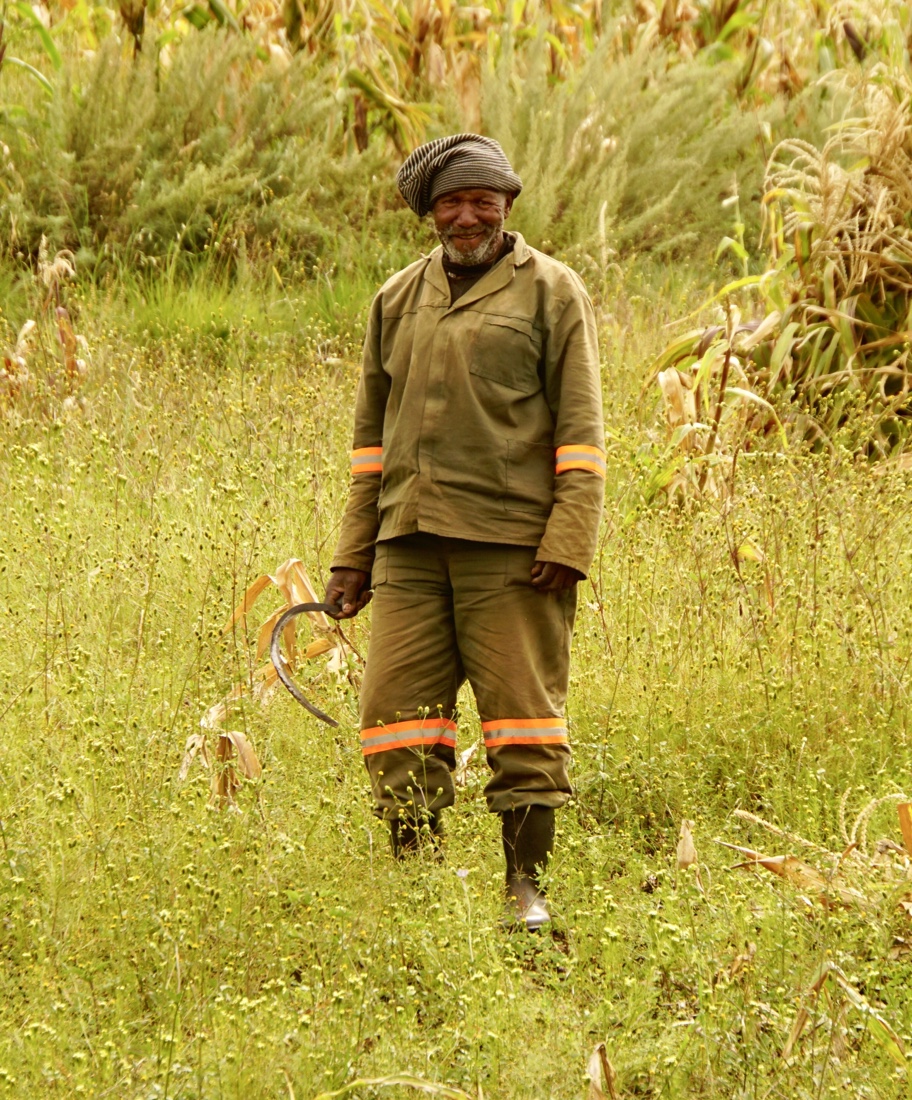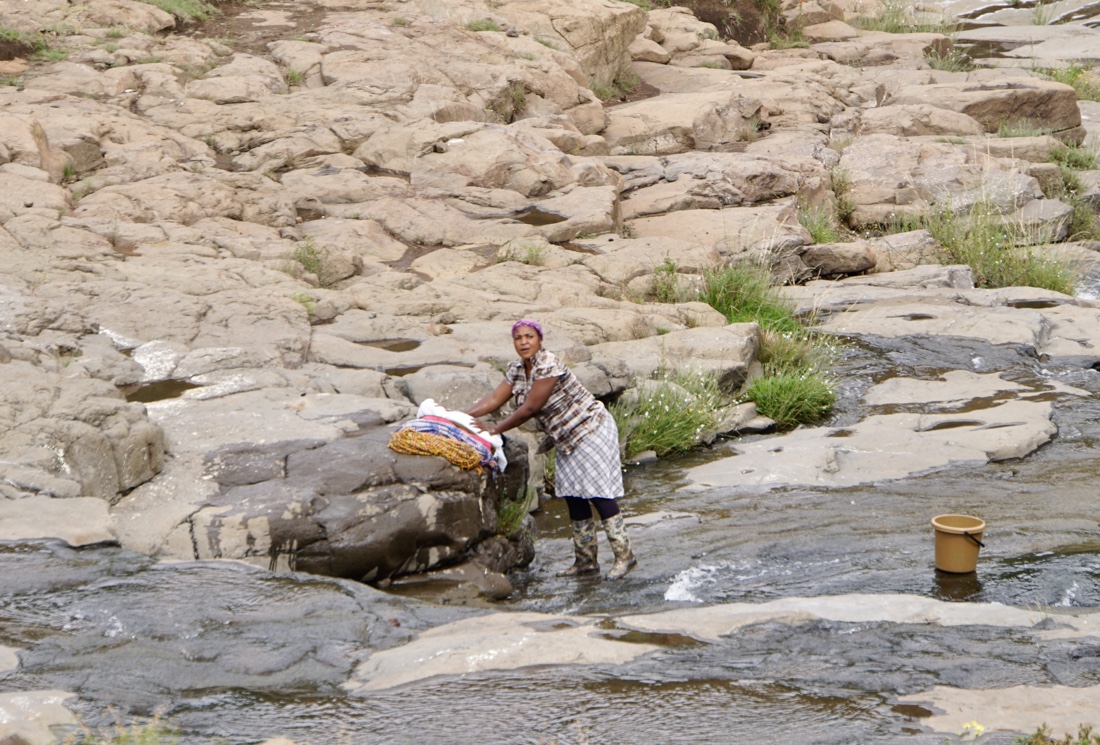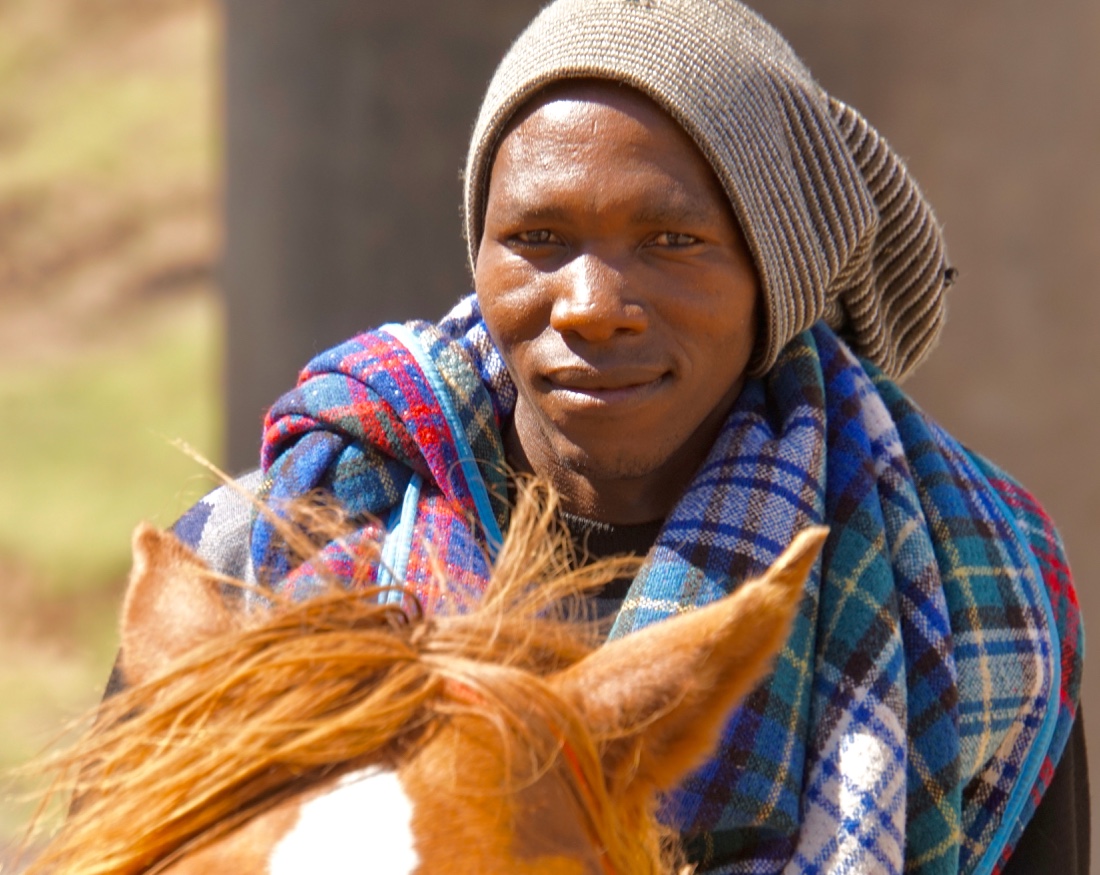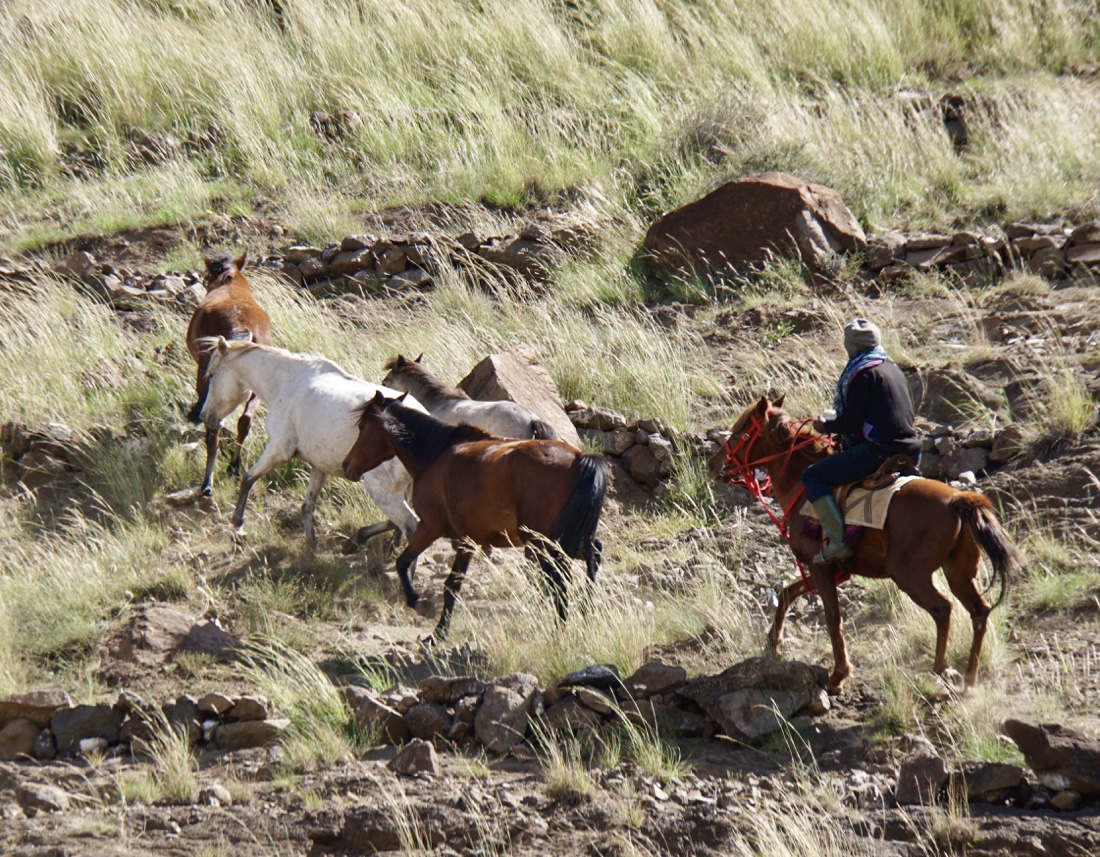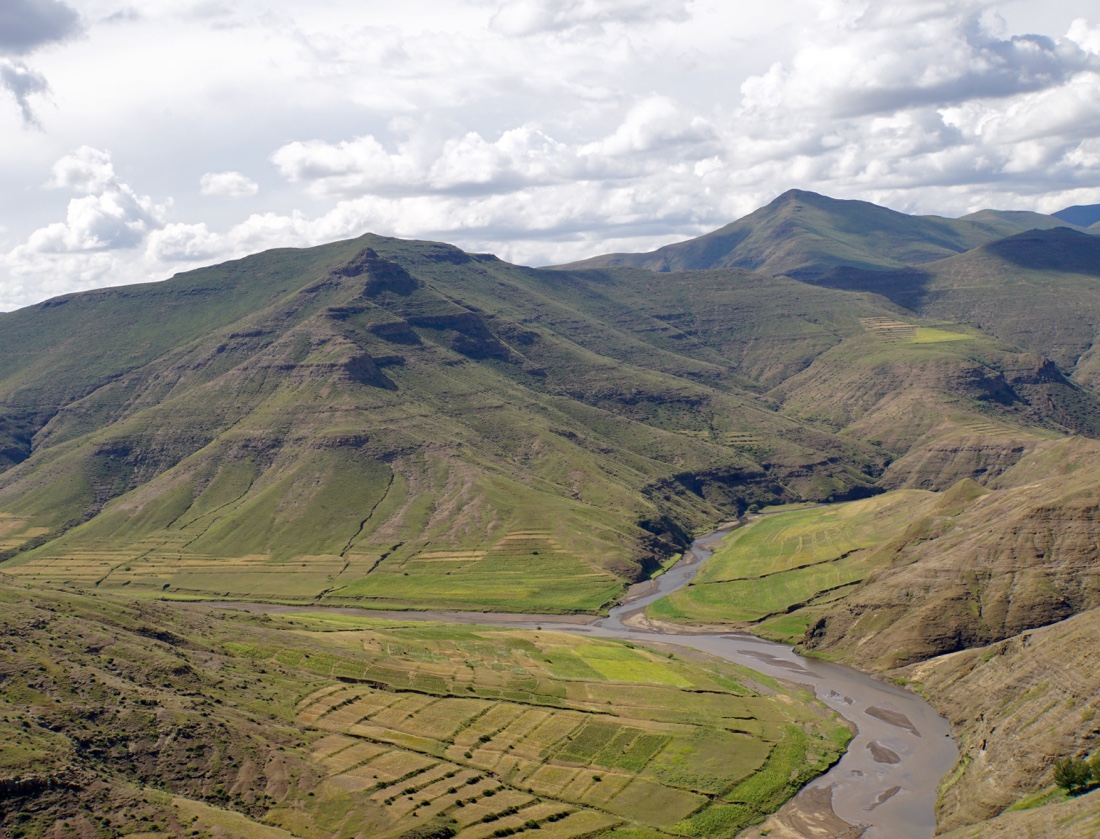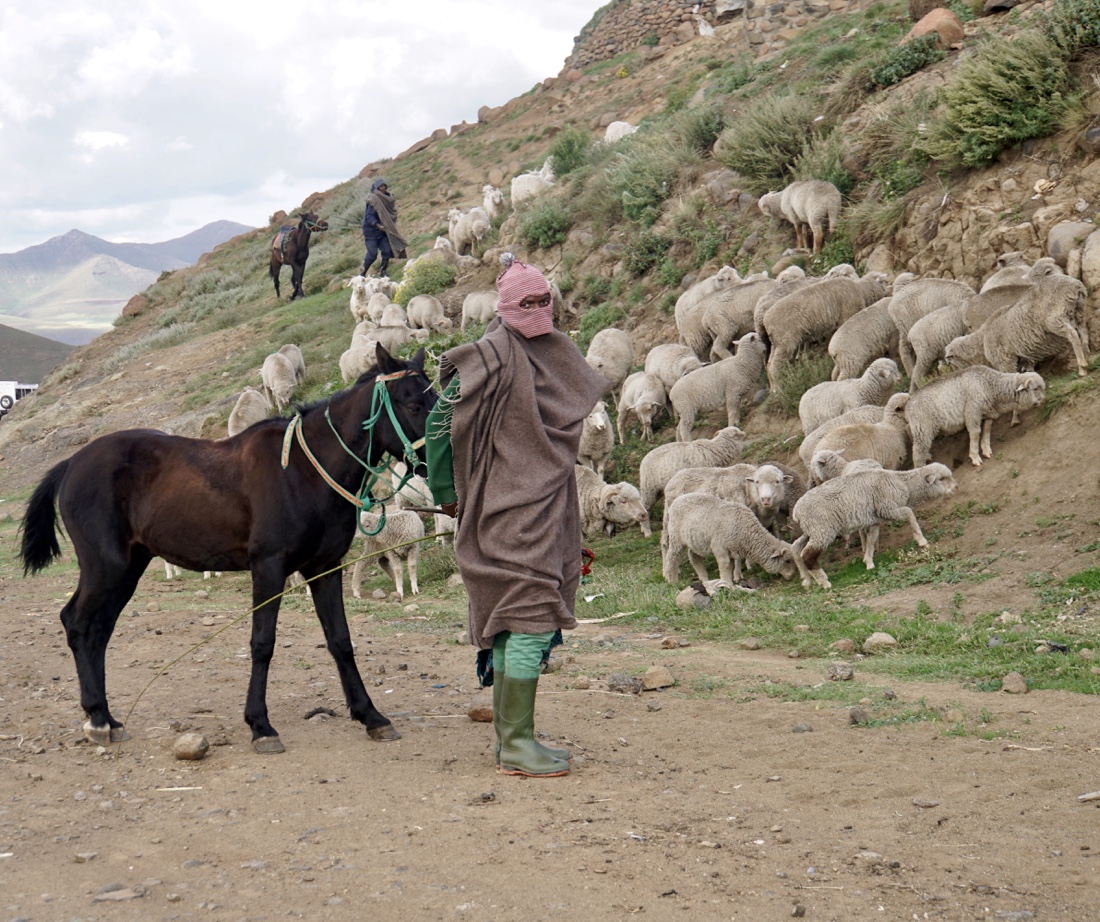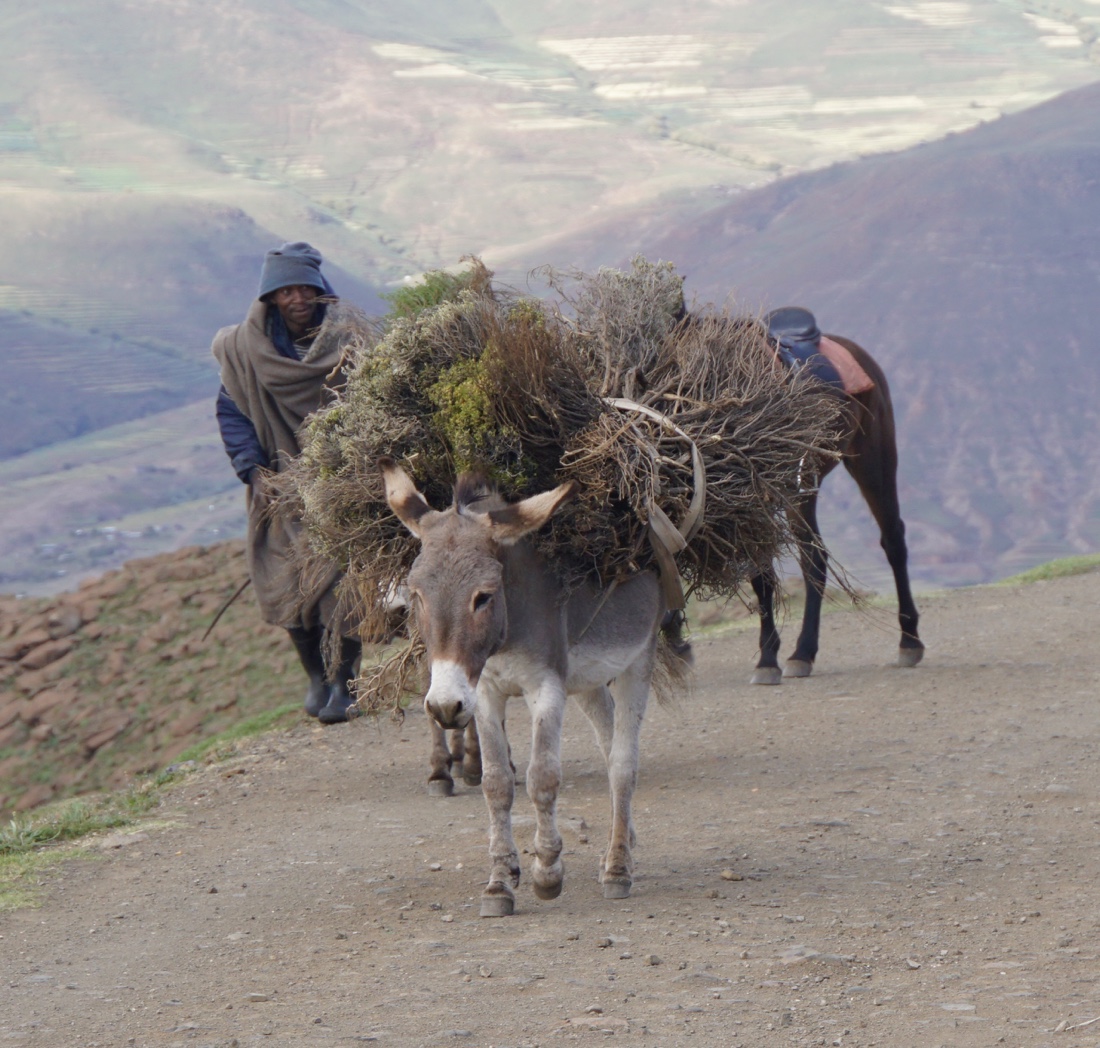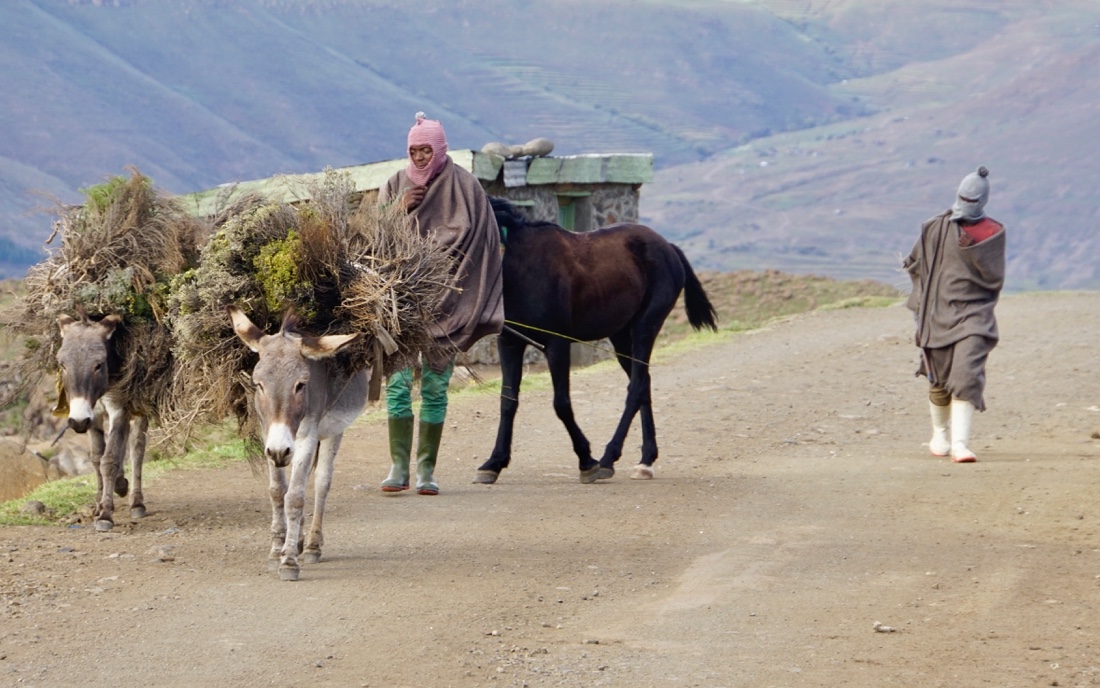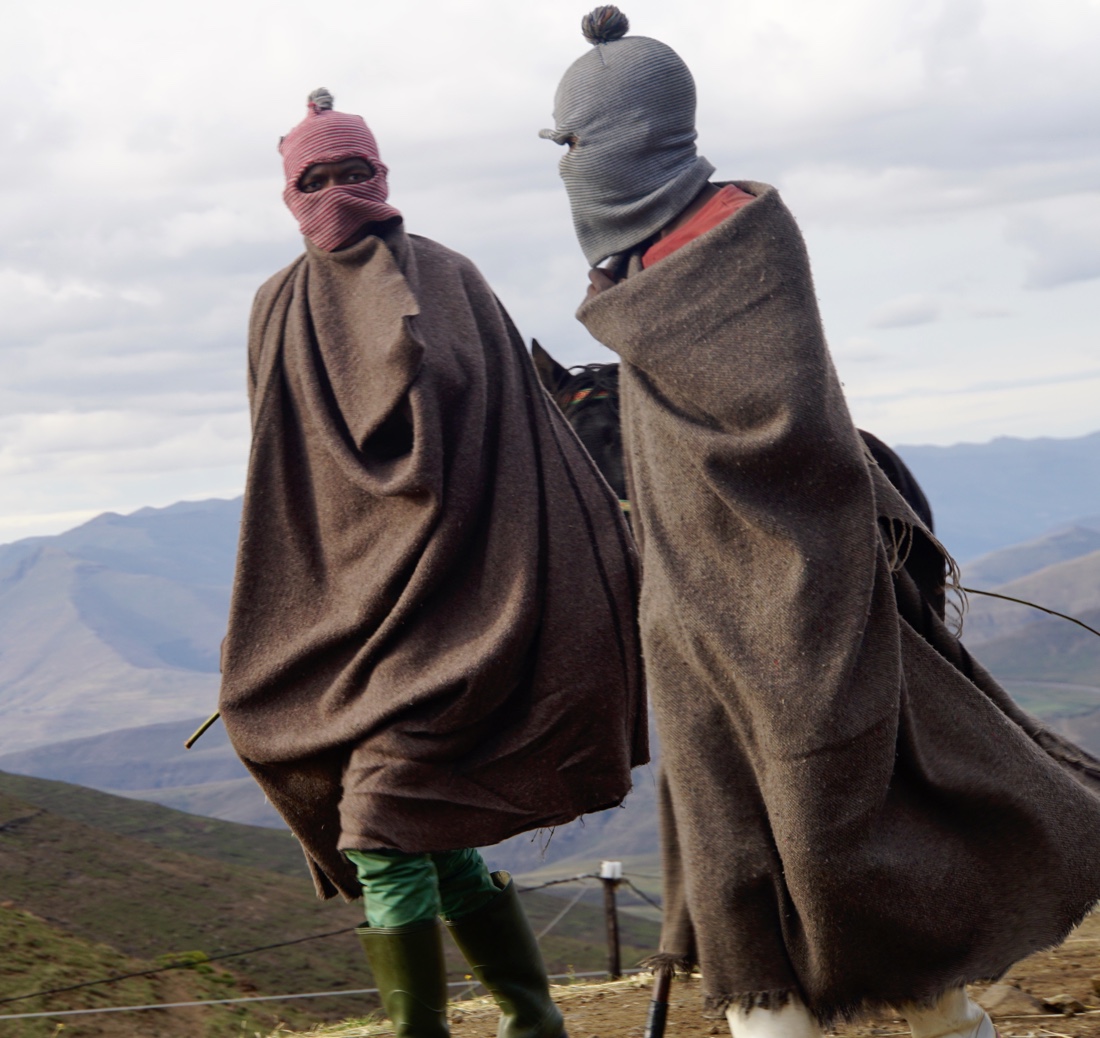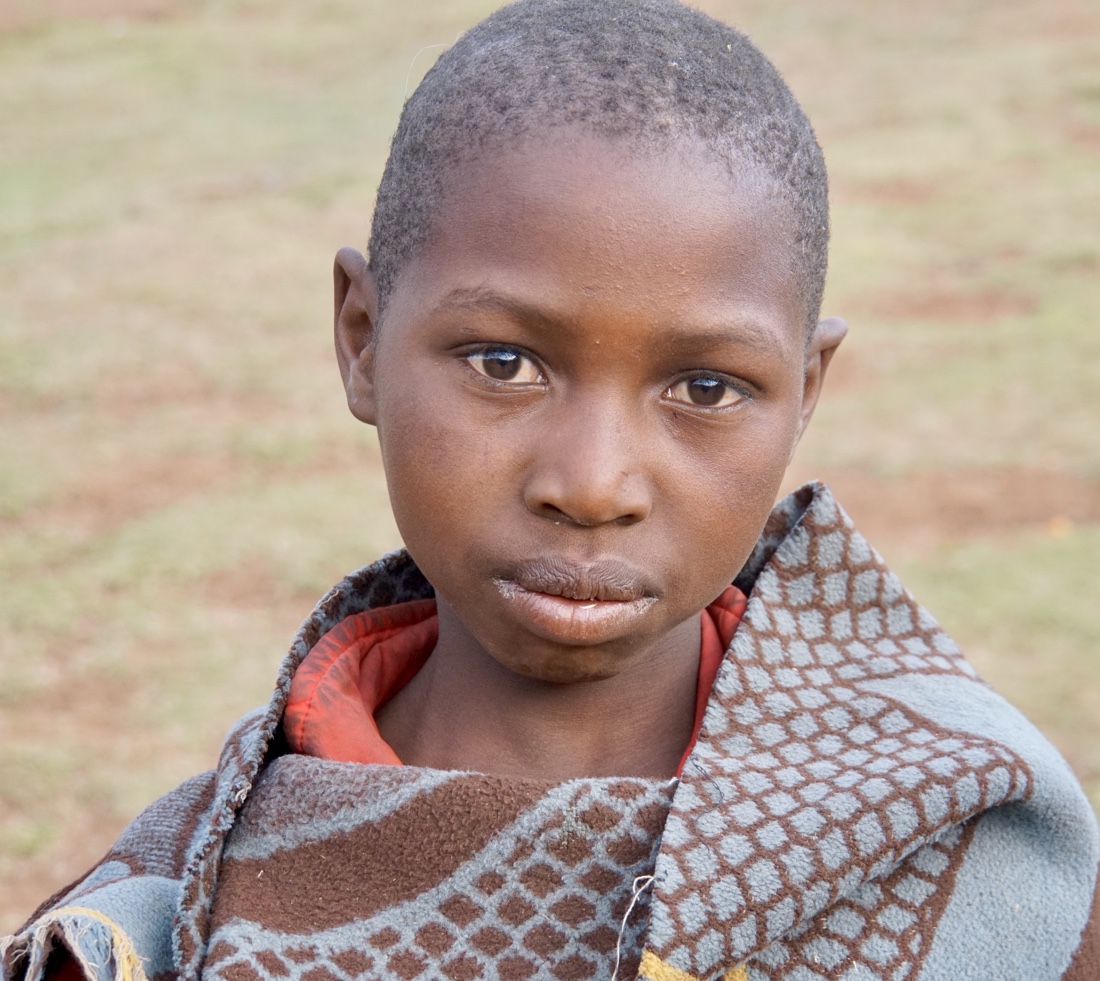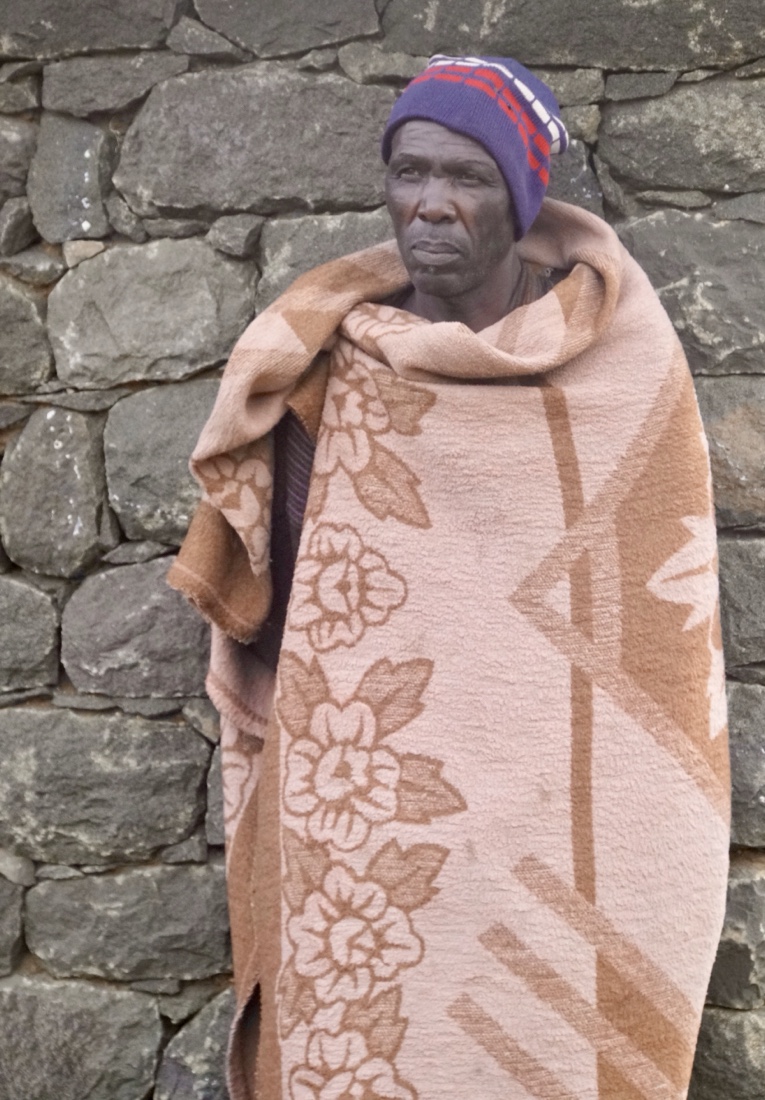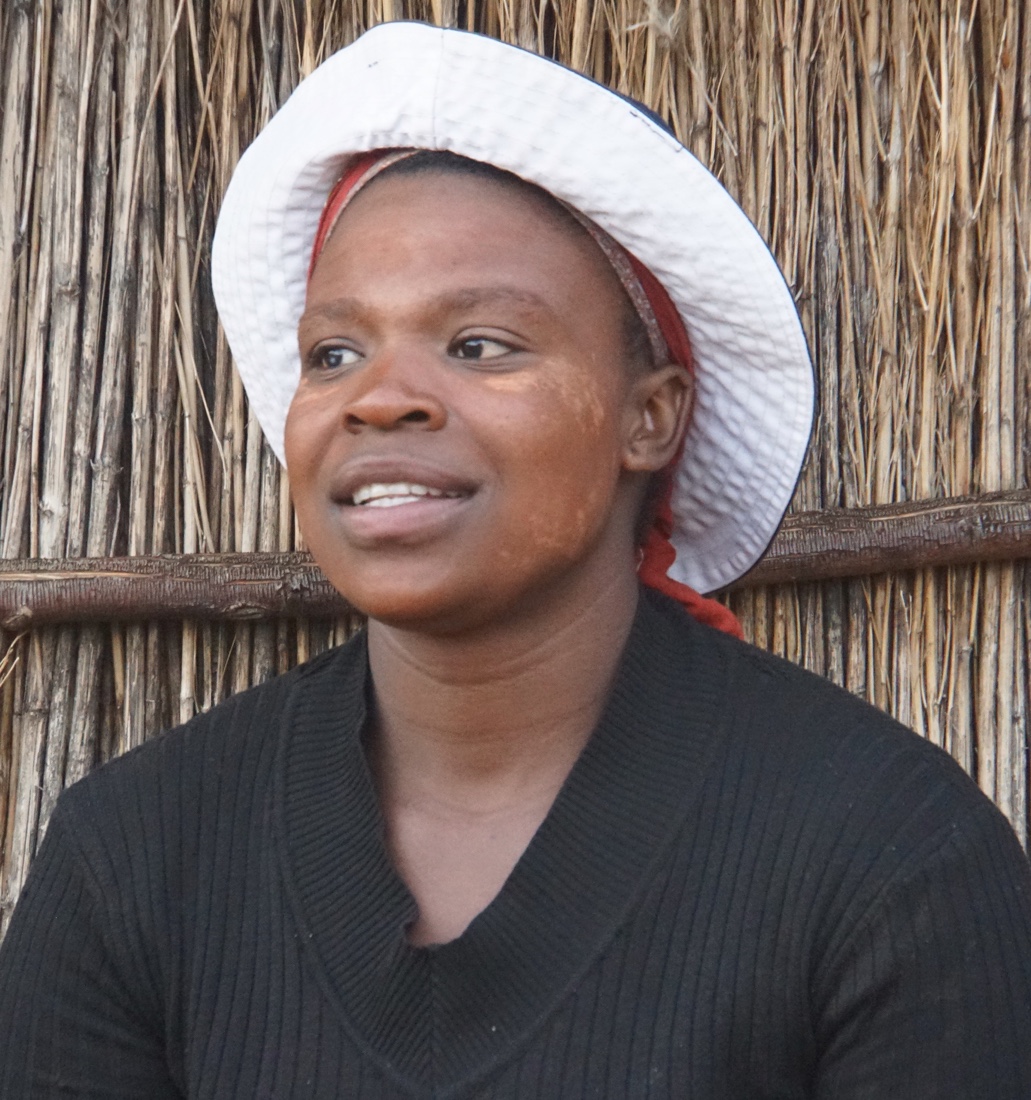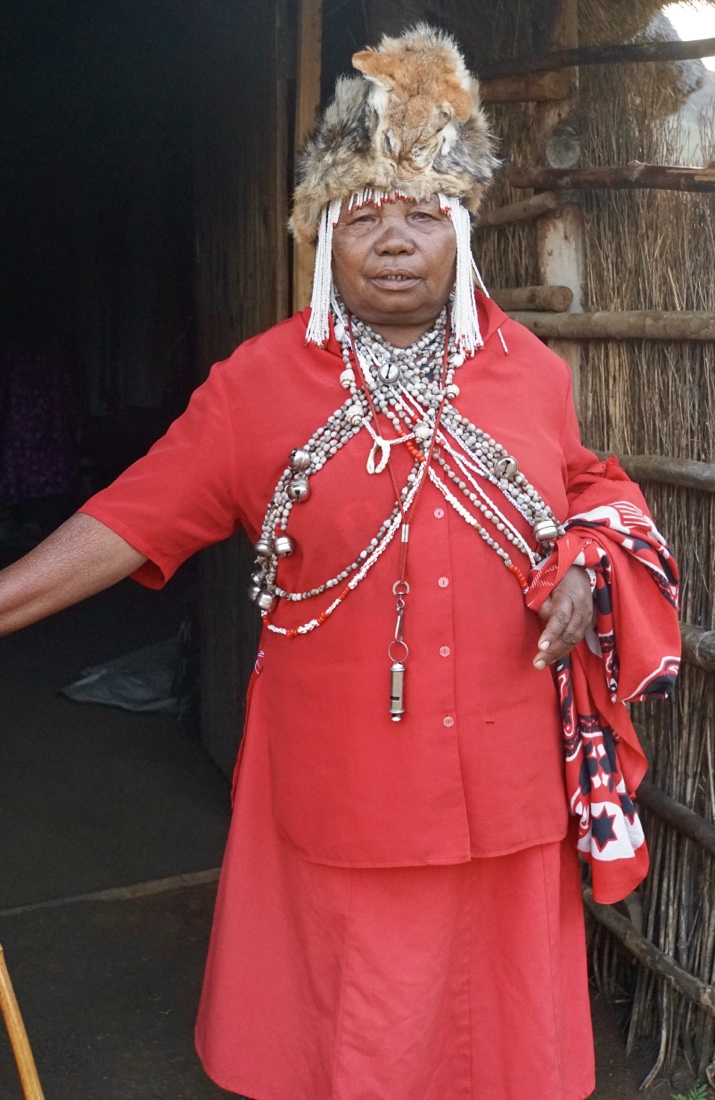April 9
We have a full day to explore Johannesburg accompanied by the amazing, and fun, Jo Buitendach. Jo has a degree in History & Archeology, and a Bachelor of Science and Honors in Archaeology from the University of the Witswaterstrand. She is currently enrolled at The University of Cape Town completing a Masters Degree in Conservation of the Built Environment. Her enthusiasm for the Johannesburg Inner City, its history, culture and rejuvenation is infectious.
Jo shows us around her favorite graffiti sites, the Public Art future developments of the Maboneng Precinct, Braamfontein and its surrounding community. We walk through an open-air museum with rich exhibits of public art, urban living, fascinating history and amazing architecture. I have seen (different) parts of these areas with Angus, early in the trip, but Jo’s familiarity with all of the artists and styles of graffiti, street art and murals that we see is extraordinary and transforms the experience. 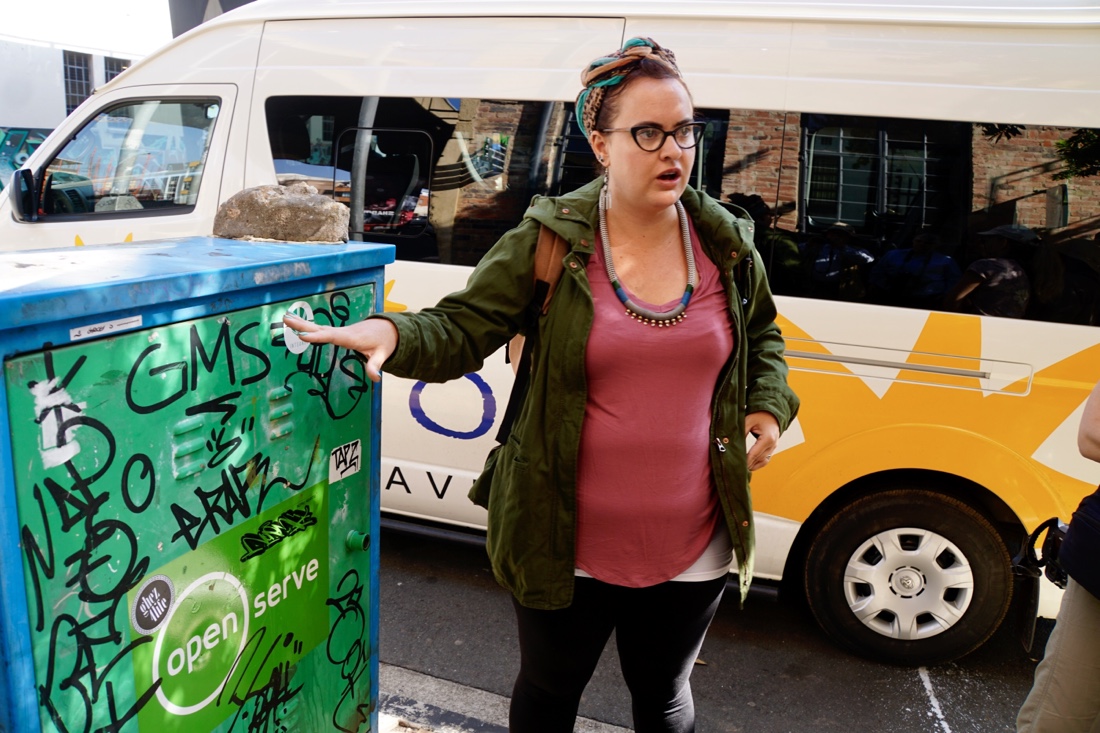 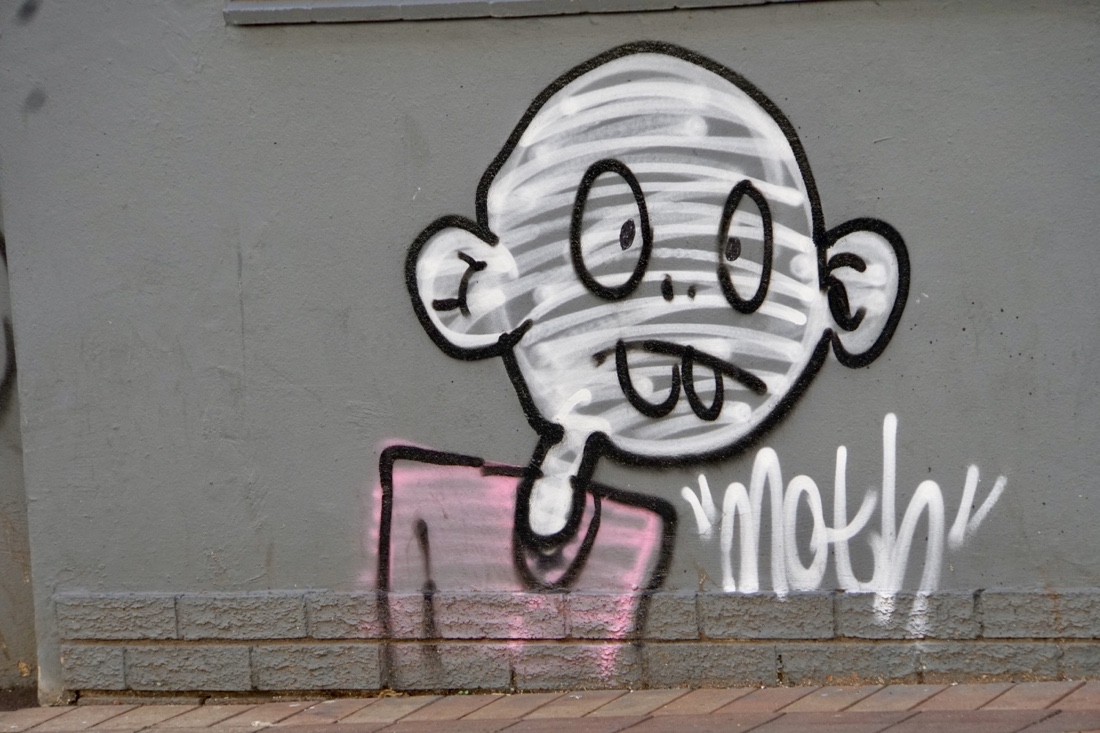 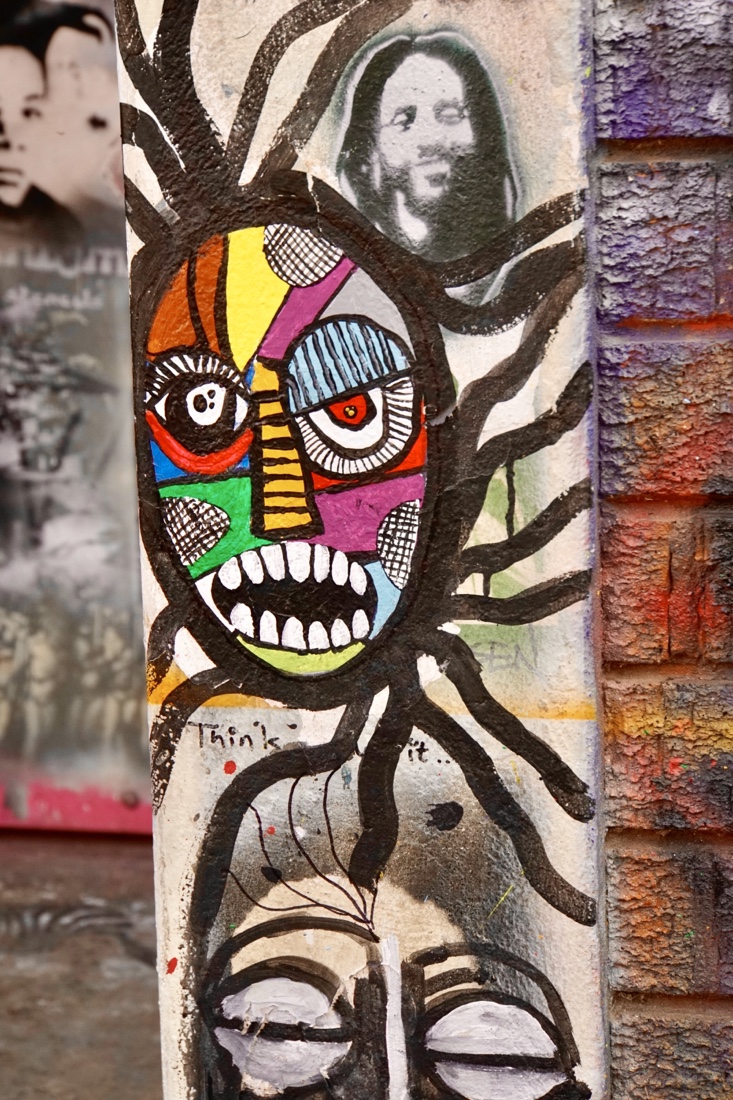 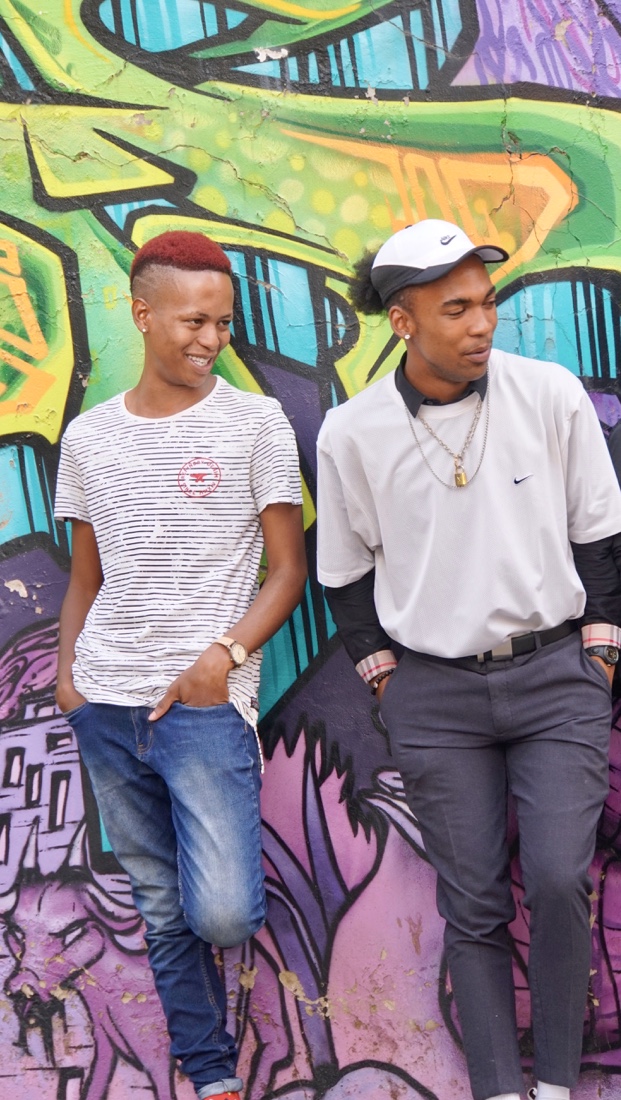 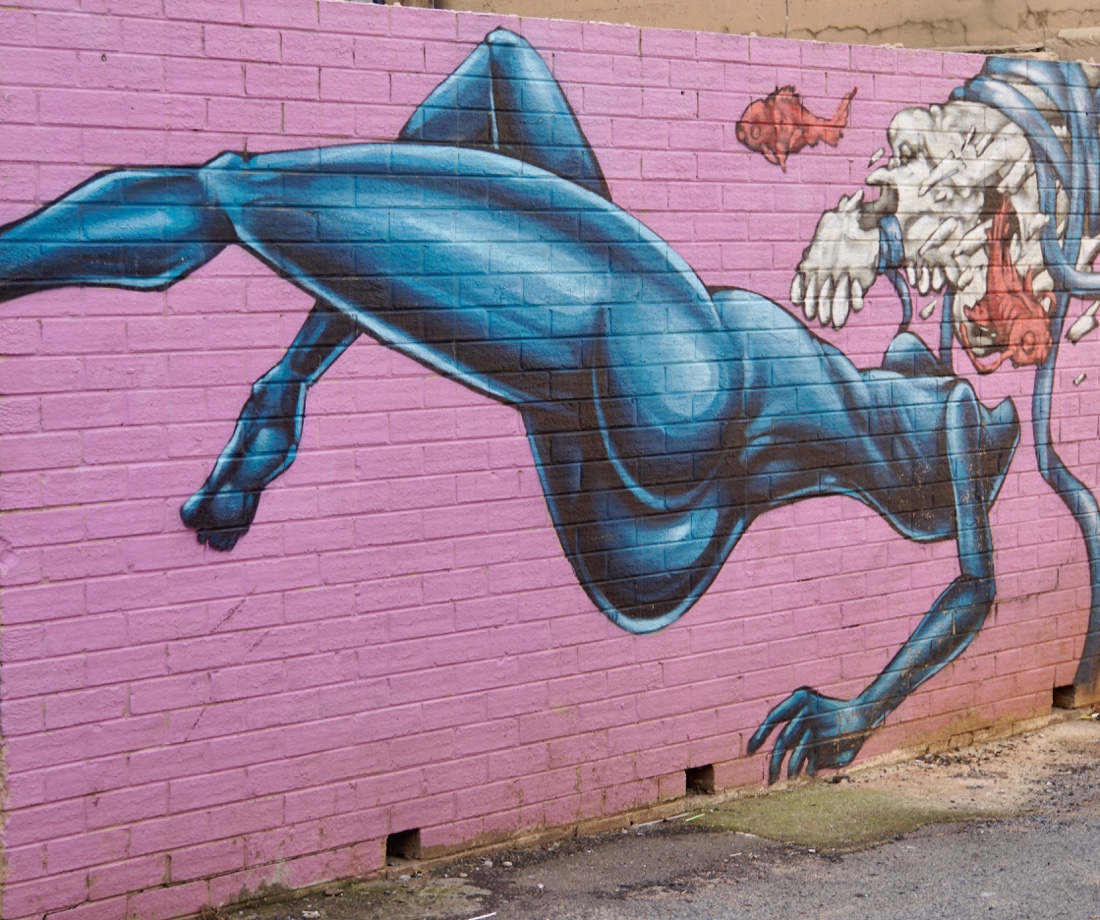 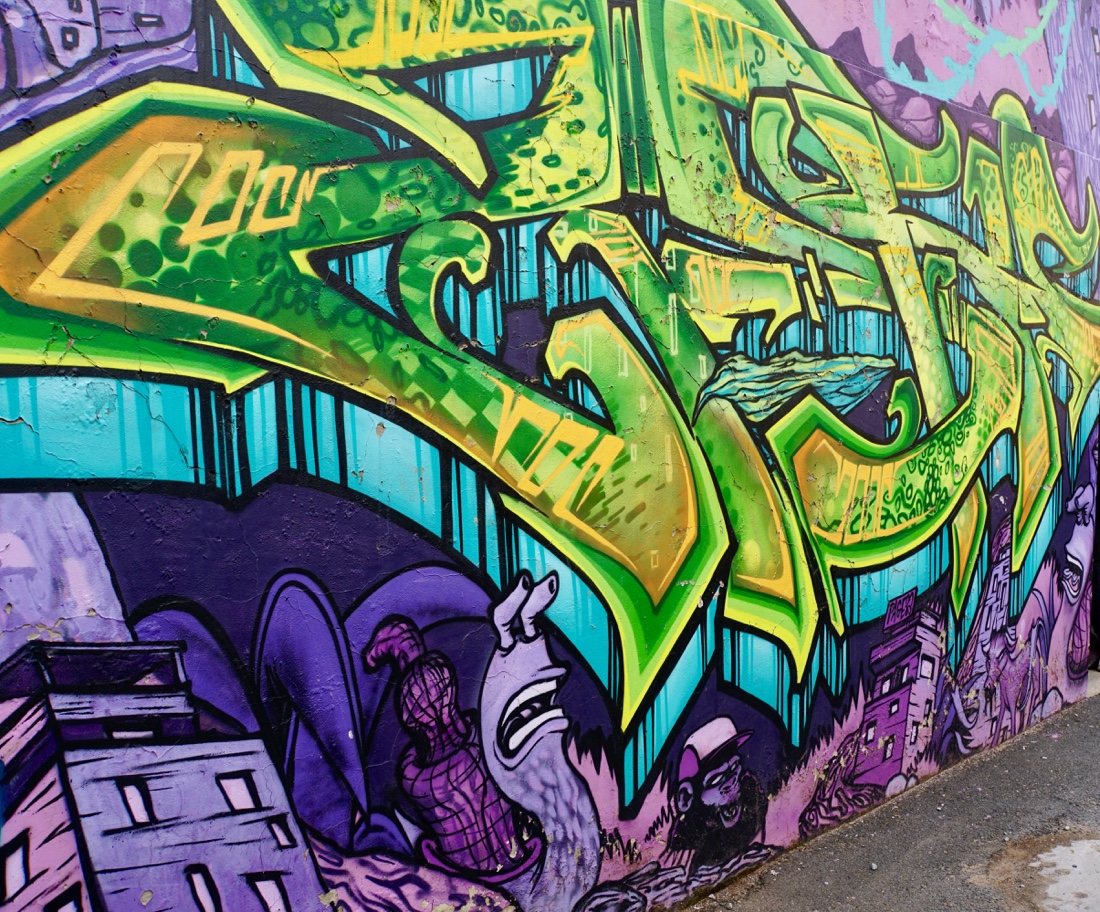 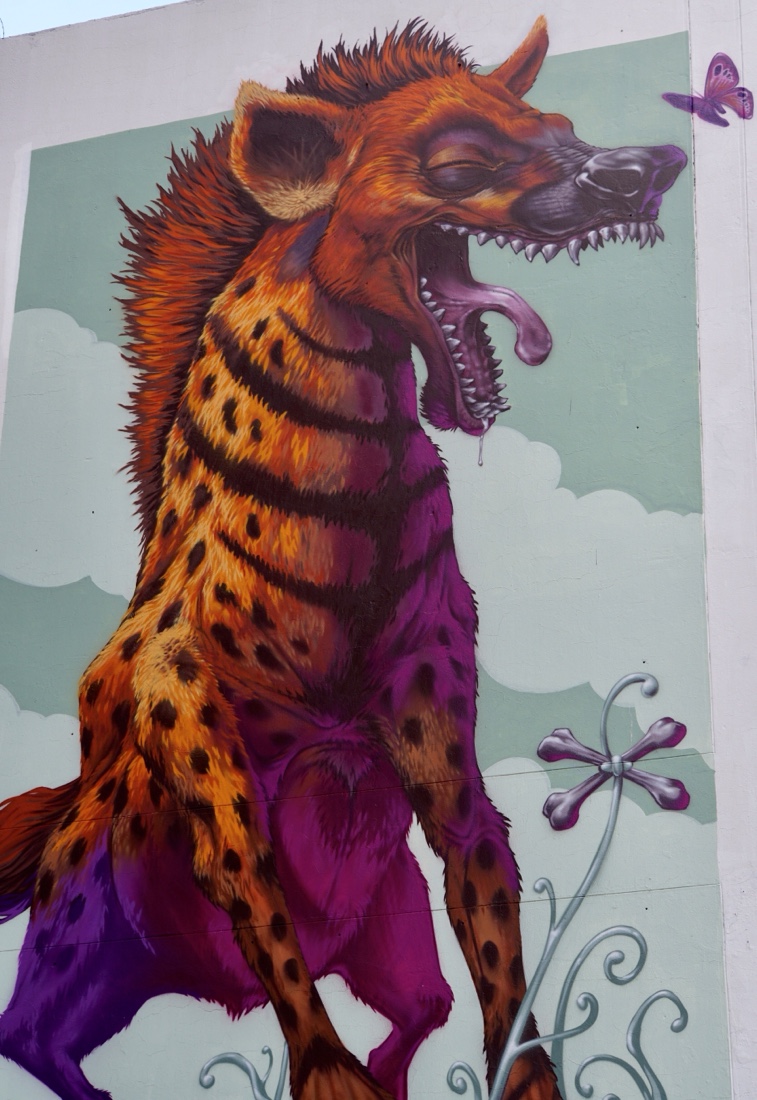 We walk into some shops and have lunch in Joburg’s most recent modern, called Victoria Square, built around a former industrial area. We walk into some shops and have lunch in Joburg’s most recent modern, called Victoria Square, built around a former industrial area.
In the afternoon we drive by the impressive football stadium 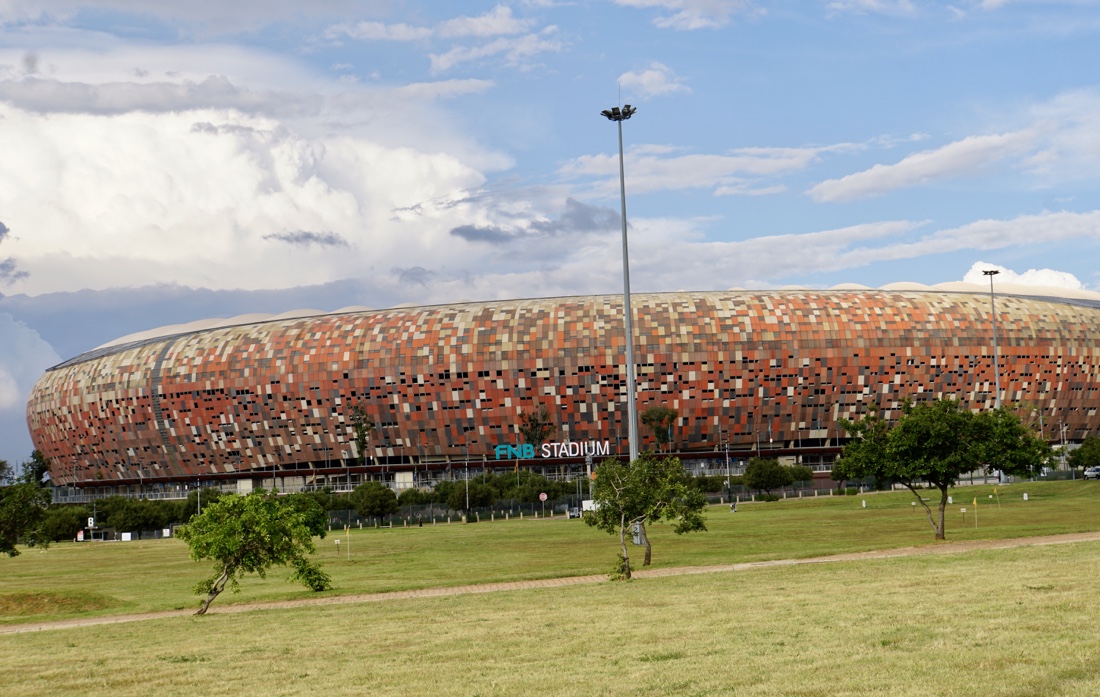 and then drive through Soweto, a township of some four million people, whose history is intimately involved with apartheid in South Africa. We drive down one street that is the only street in the world on which two Nobel Peace Laureates lived, Nelson Mandela and Bishop Desmond Tutu. While some of the areas of Soweto are now well-to-do and rather upscale, most of it reflects the image that people have of the area. and then drive through Soweto, a township of some four million people, whose history is intimately involved with apartheid in South Africa. We drive down one street that is the only street in the world on which two Nobel Peace Laureates lived, Nelson Mandela and Bishop Desmond Tutu. While some of the areas of Soweto are now well-to-do and rather upscale, most of it reflects the image that people have of the area. 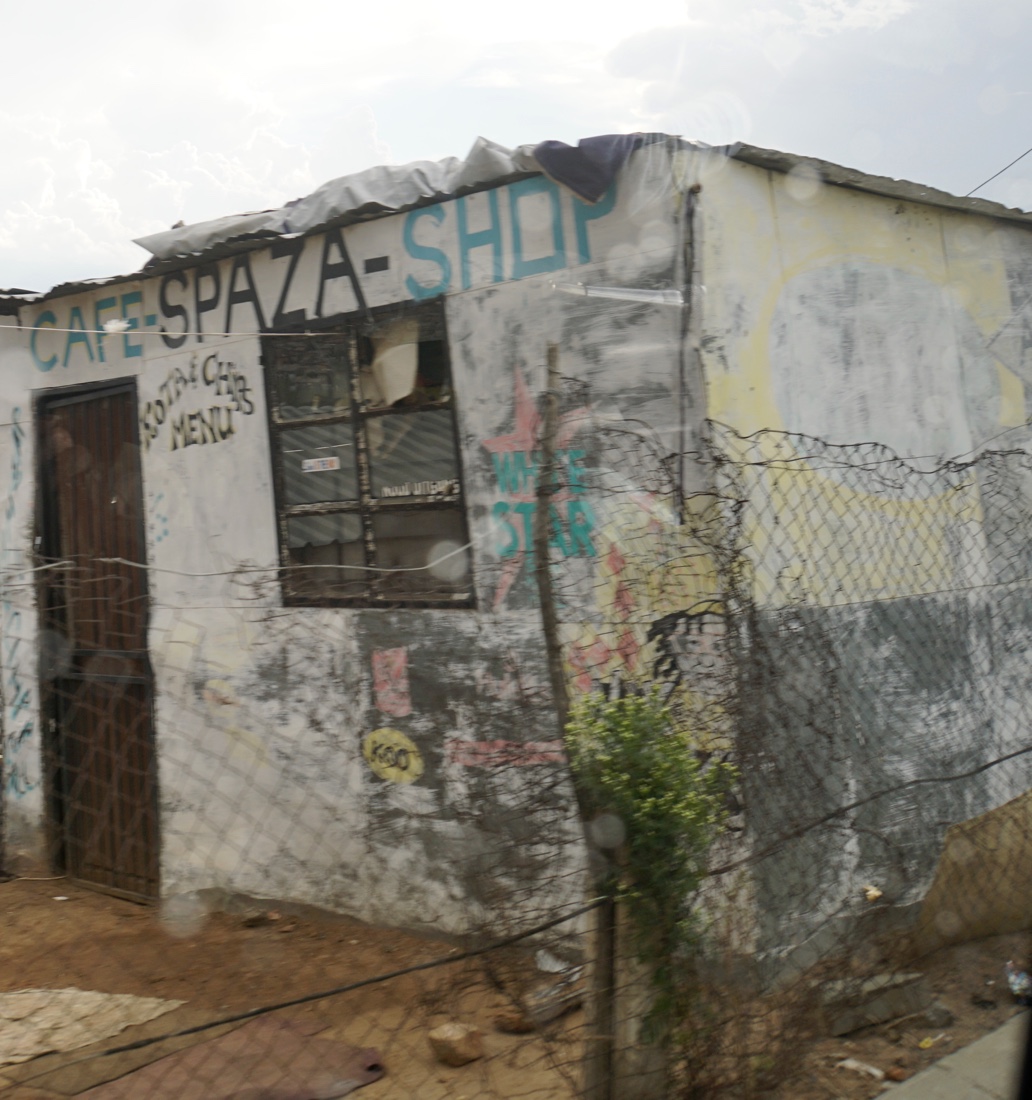 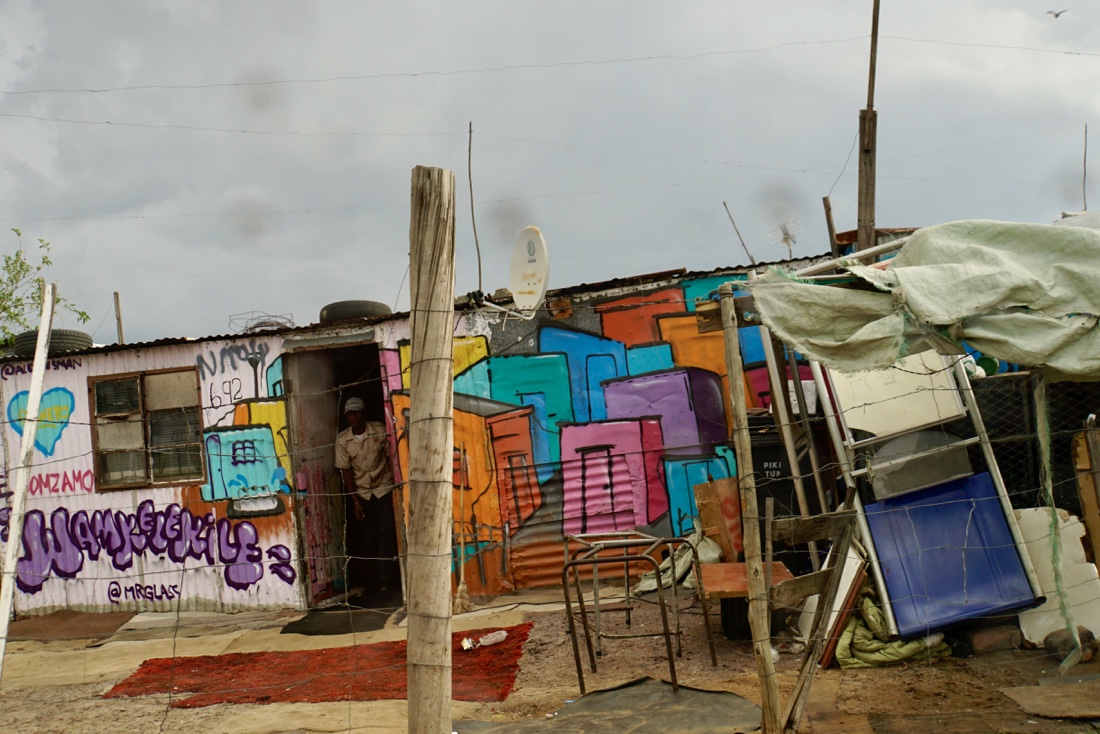 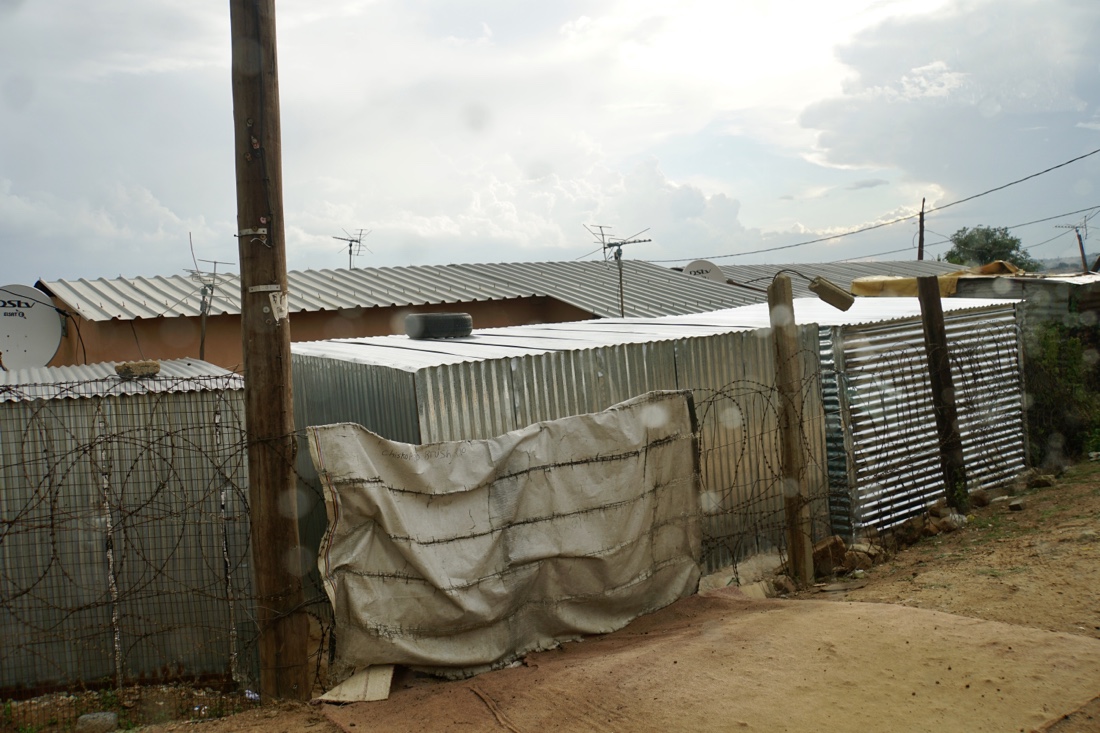 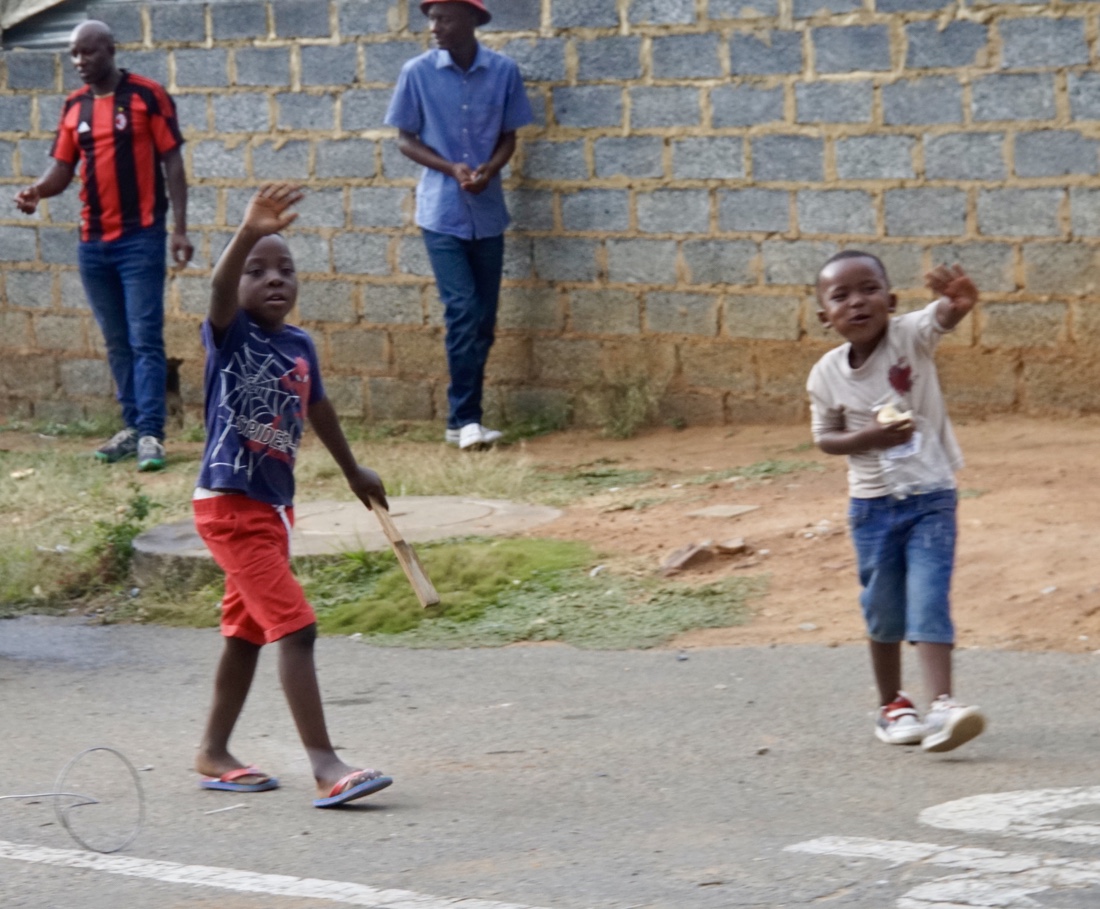
In the evening we have a farewell dinner, though only Stan and I will not be joining the group on a three-day safari. Two young men entertain us at the dinner. 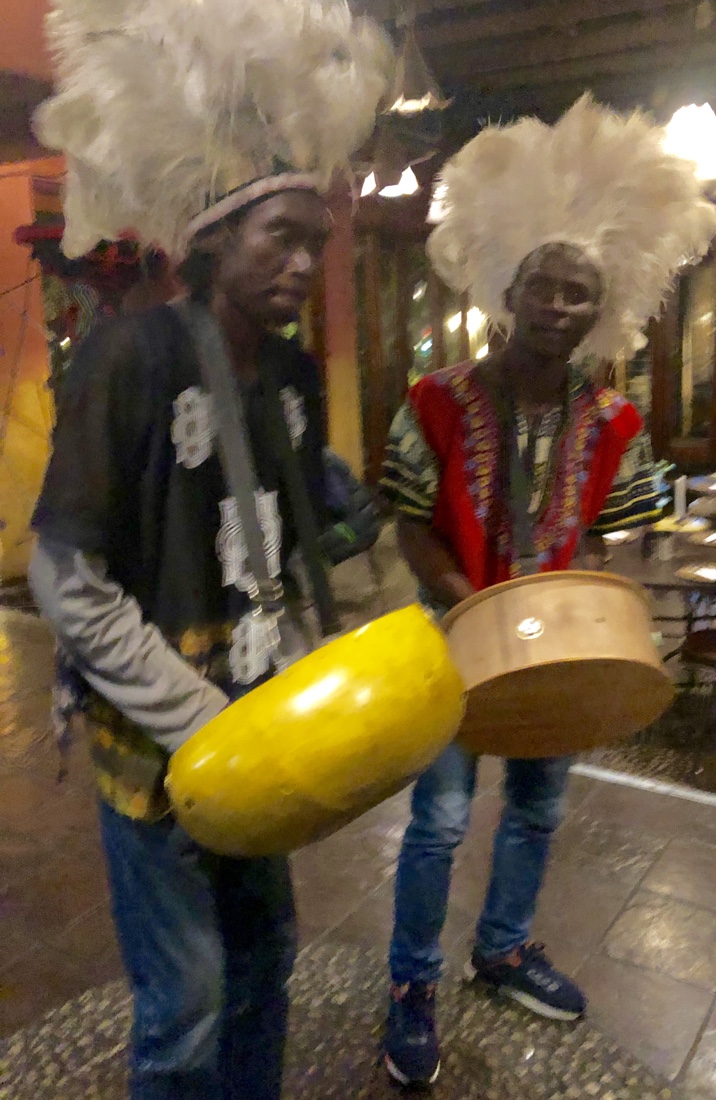 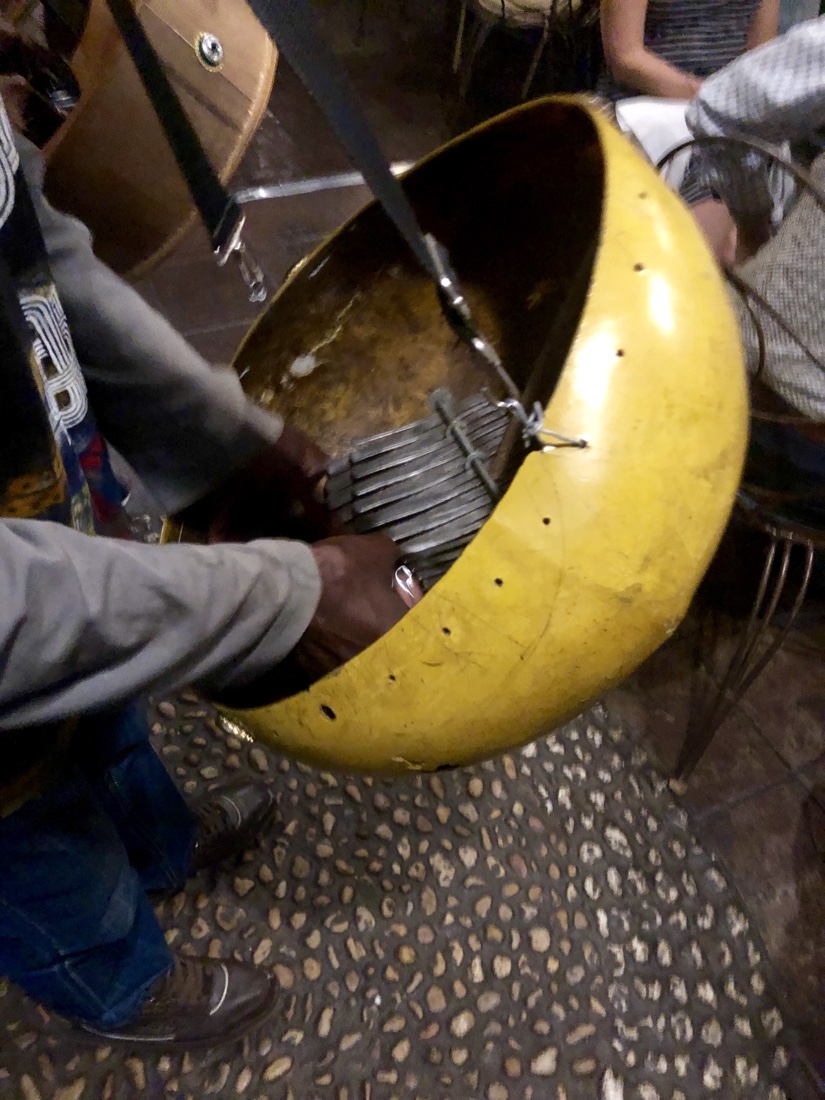 Prior to the dinner, I read the “real South African blog,” to the group which takes a light look at what transpired on the trip. The “real blog” is well received. Prior to the dinner, I read the “real South African blog,” to the group which takes a light look at what transpired on the trip. The “real blog” is well received.
Stan and I bid farewell to the group, who will be leaving early in the morning.
April 7 and 8
Before breakfast and checkout we head to the beach to photograph groups of traditional healers and religious groups that usually come on Sundays to pray at sunrise. The scene is interesting, but disturbing to me, as those being initiated are treated very roughly and seem in danger of drowning.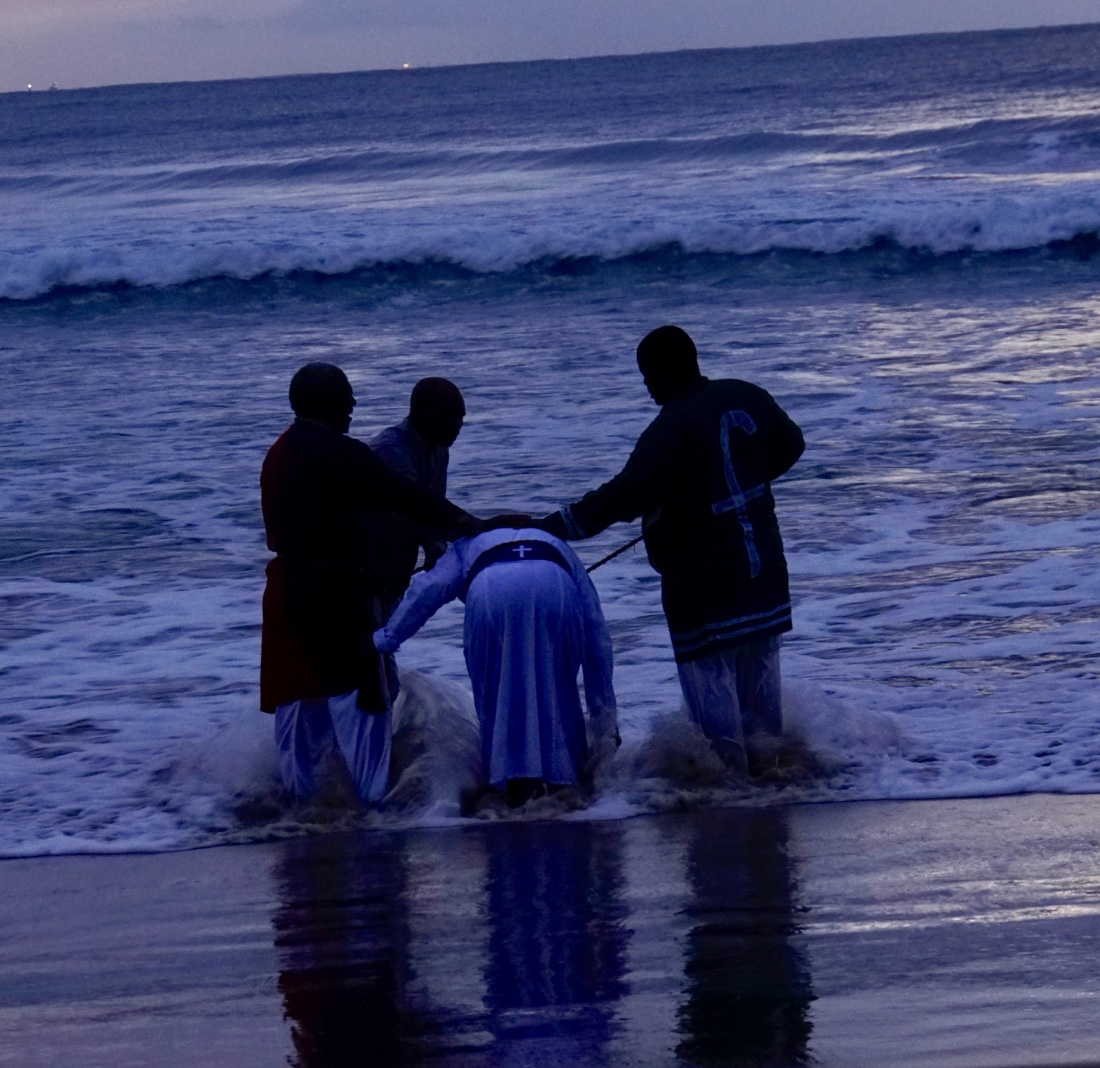
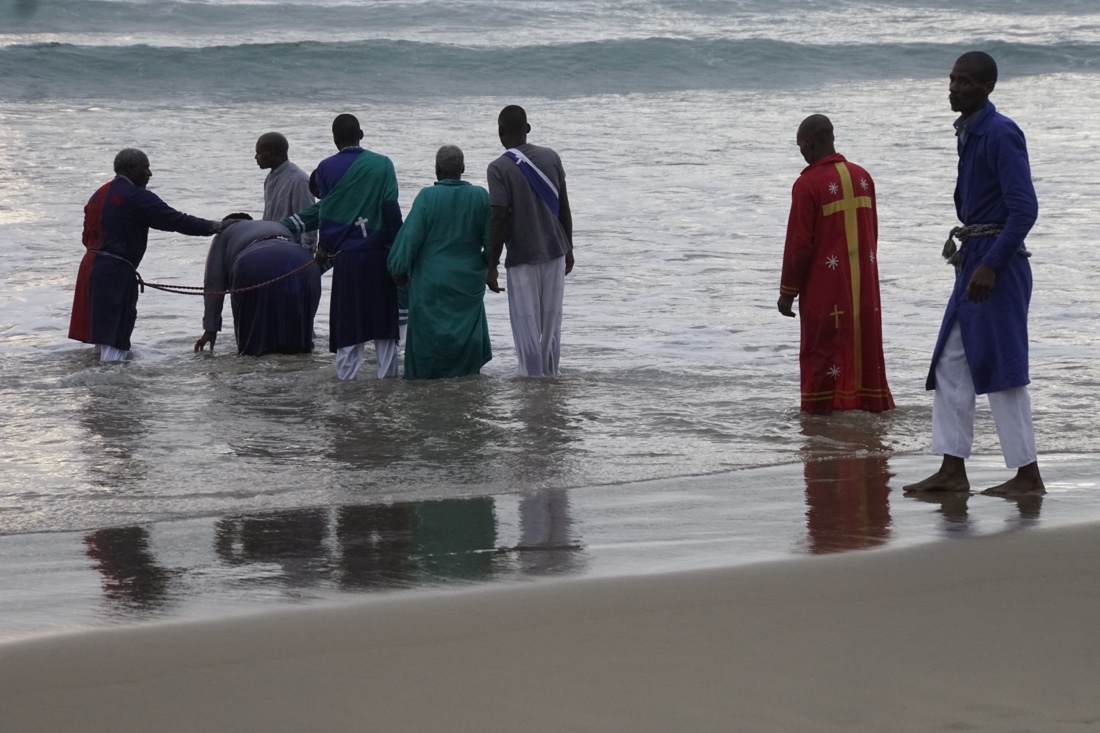 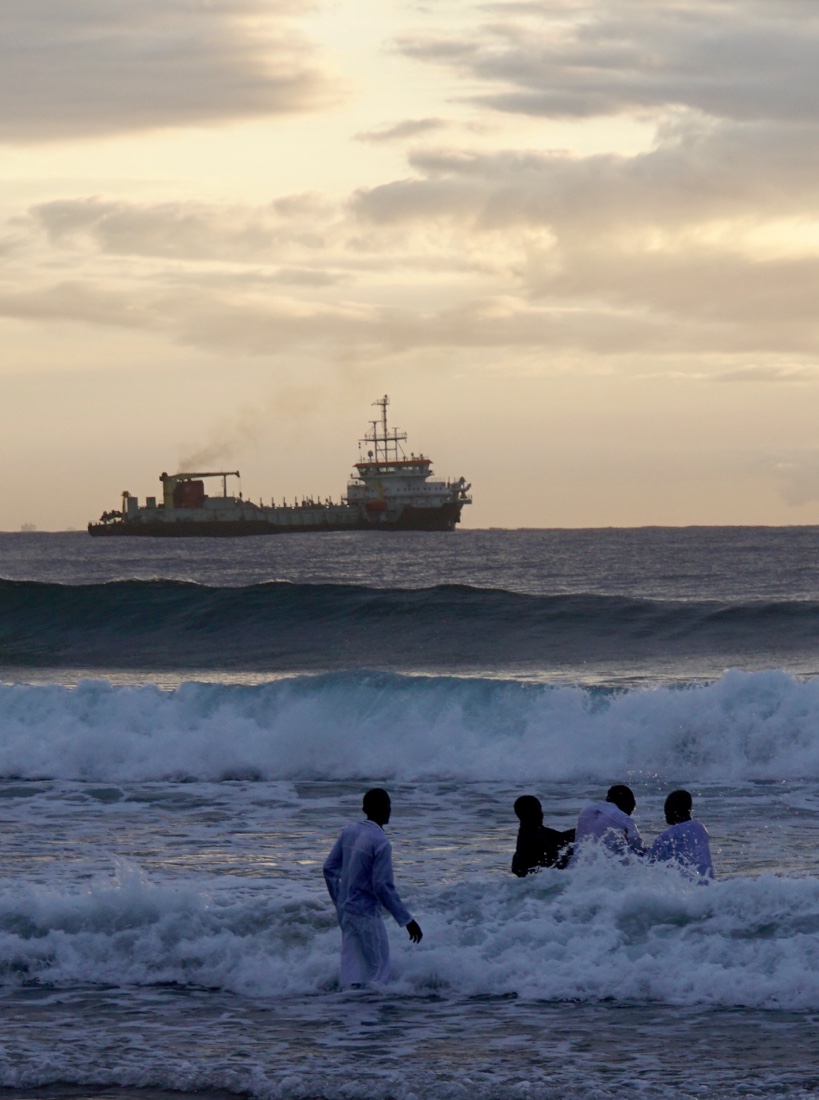 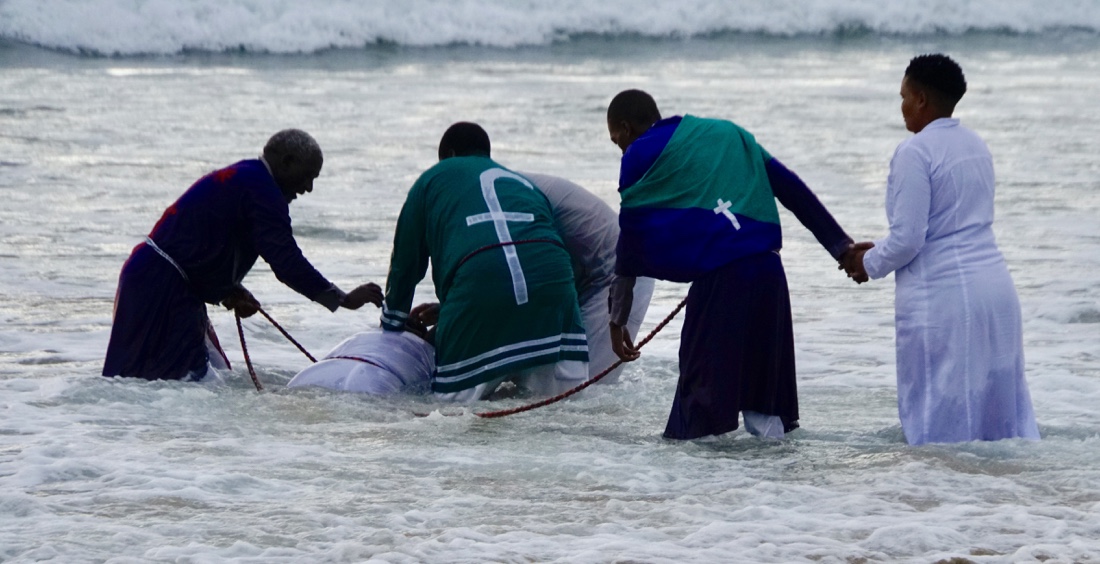 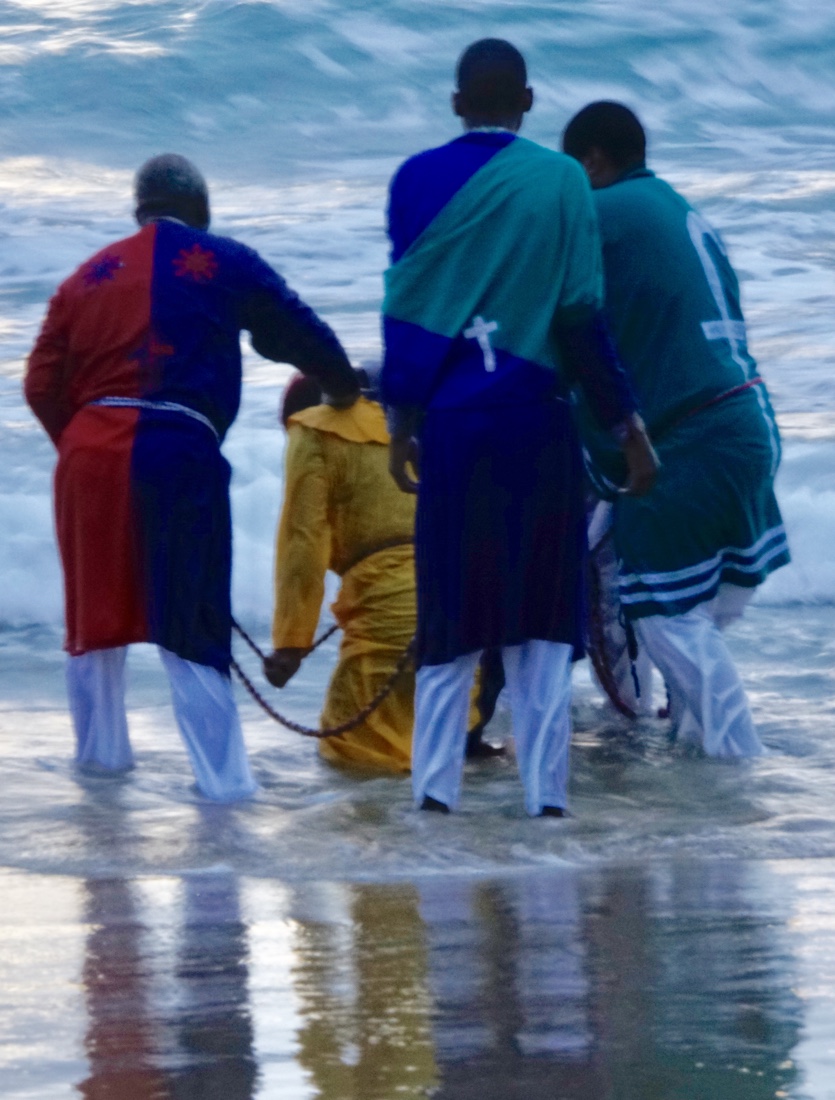 We return to the hotel for a quick breakfast and then head south, past Port Shepstone to another Zulu community in the foothills of the Ntantana Mountain overlooking both the Nyandezulu Waterfall and the sea. Dudu Malinga welcomes us into her home where she lives with her daughter, grandchild and nephew in a rural Zulu Village. We return to the hotel for a quick breakfast and then head south, past Port Shepstone to another Zulu community in the foothills of the Ntantana Mountain overlooking both the Nyandezulu Waterfall and the sea. Dudu Malinga welcomes us into her home where she lives with her daughter, grandchild and nephew in a rural Zulu Village.
We meet Sharon, who leads us deep into the community of the KwaNzimakwe, meeting elders of the community including Mr Dlezi, who is an elder in this small village, a full member of the Shembe Church. The people in this community are also connected to the WOWZulu organization.
Afterwards we visit a number of different “sangomas” (traditional healers or shamans) and participate in their rituals. The women in our group have to improvise skirts out of scarves.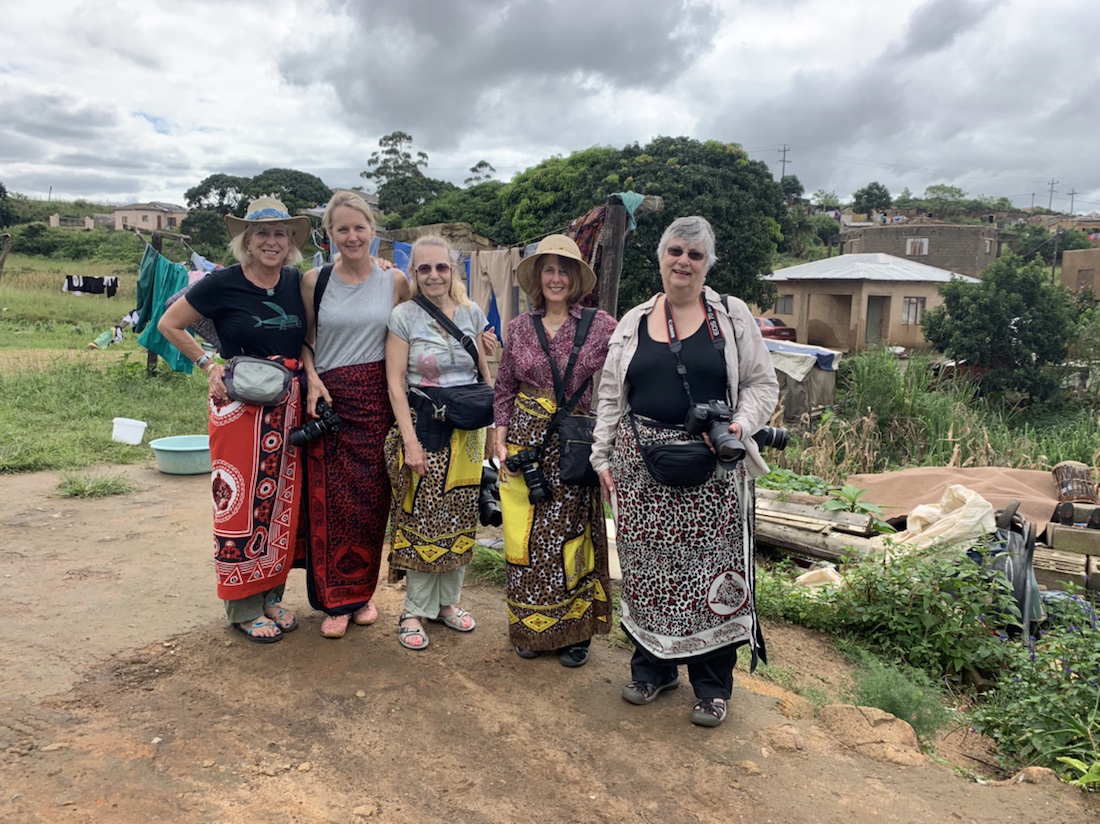 Sangomas are traditional healers of South Africa, practitioners of traditional African medicine. They fulfill different social and political roles in the community, including divination, healing physical, emotional and spiritual illnesses, directing birth or death rituals, finding lost cattle, protecting warriors, counteracting witchcraft, and narrating the history, cosmology, and myths of their tradition. Sangomas are traditional healers of South Africa, practitioners of traditional African medicine. They fulfill different social and political roles in the community, including divination, healing physical, emotional and spiritual illnesses, directing birth or death rituals, finding lost cattle, protecting warriors, counteracting witchcraft, and narrating the history, cosmology, and myths of their tradition.
There are two main types of traditional healers within the Nguni, Sotho-Tswana, and Tsonga societies of Southern Africa: the diviner(sangoma), and the herbalist (inyanga). These healers are effectively South African shamans who are highly revered and respected in a society where illness is thought to be caused by witchcraft, pollution (contact with impure objects or occurrences) or through neglect of the ancestors. It is estimated that there are as many as 200,000 indigenous traditional healers in South Africa compared to 25,000 Western-trained doctors. 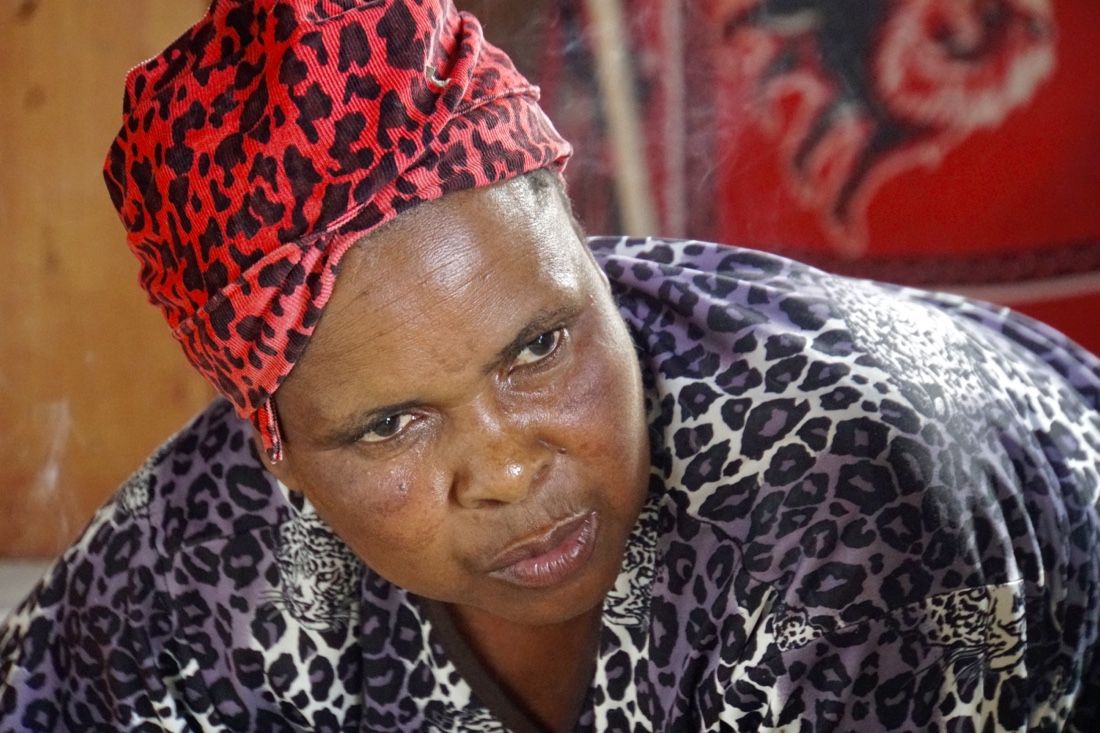 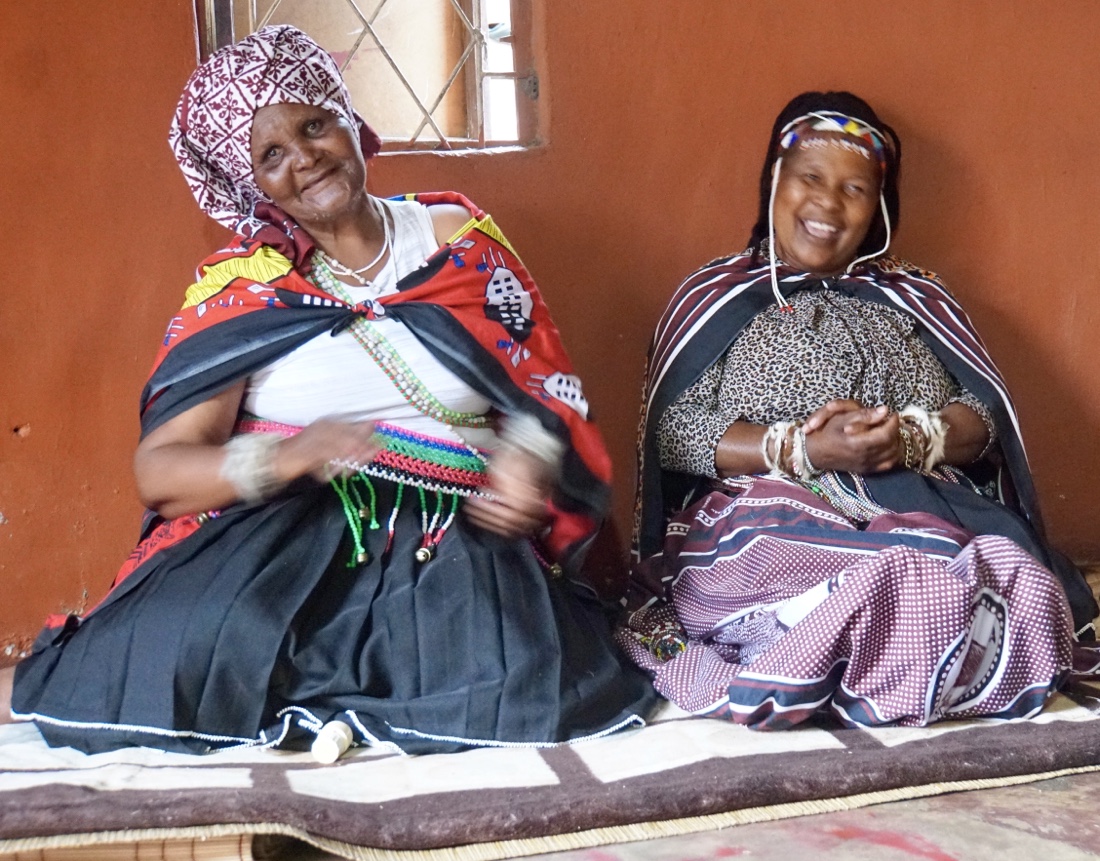 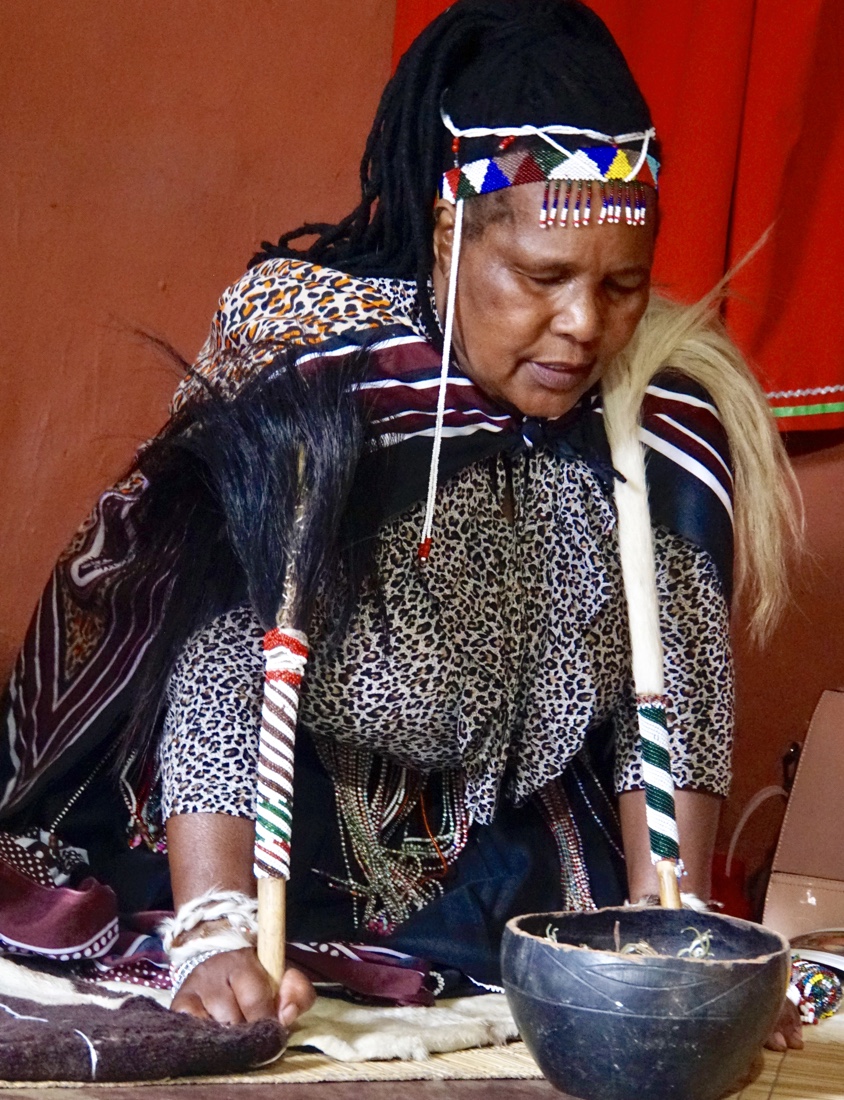
we visit with an elderly Shembe couple (Mr and Mrs Dlezi) and, of course, encounter the inevitable cute little boy.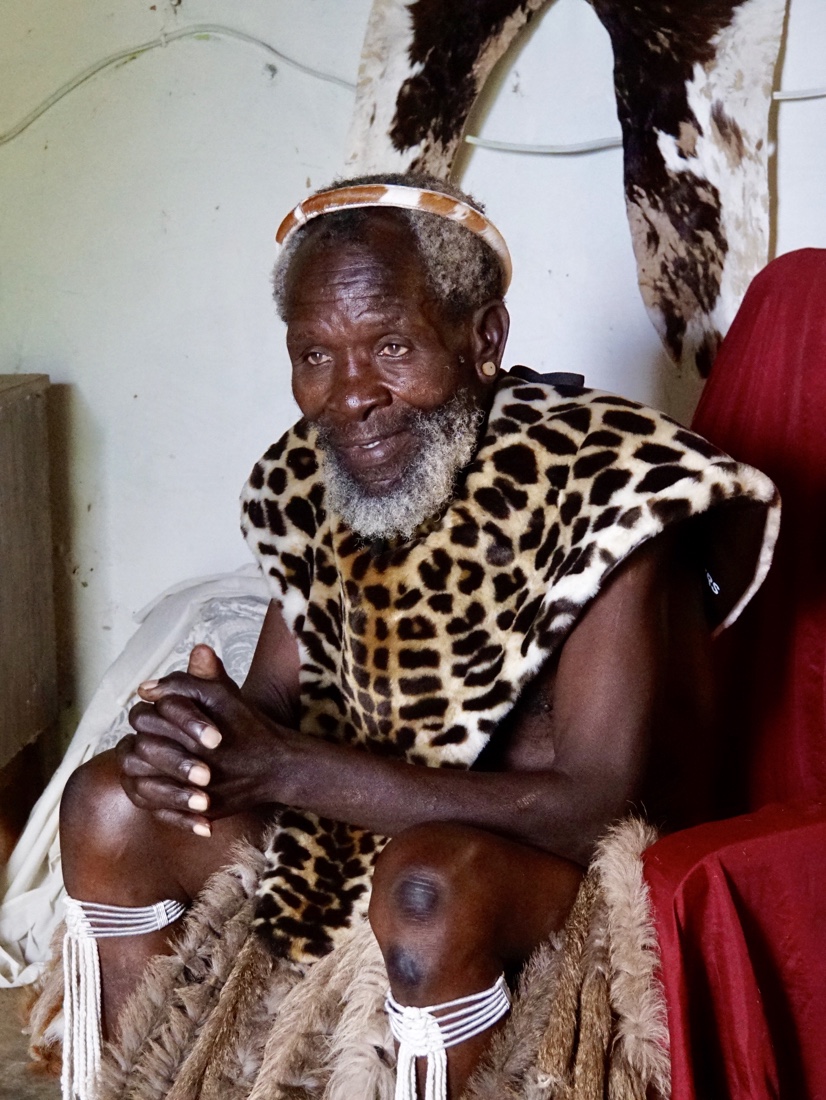 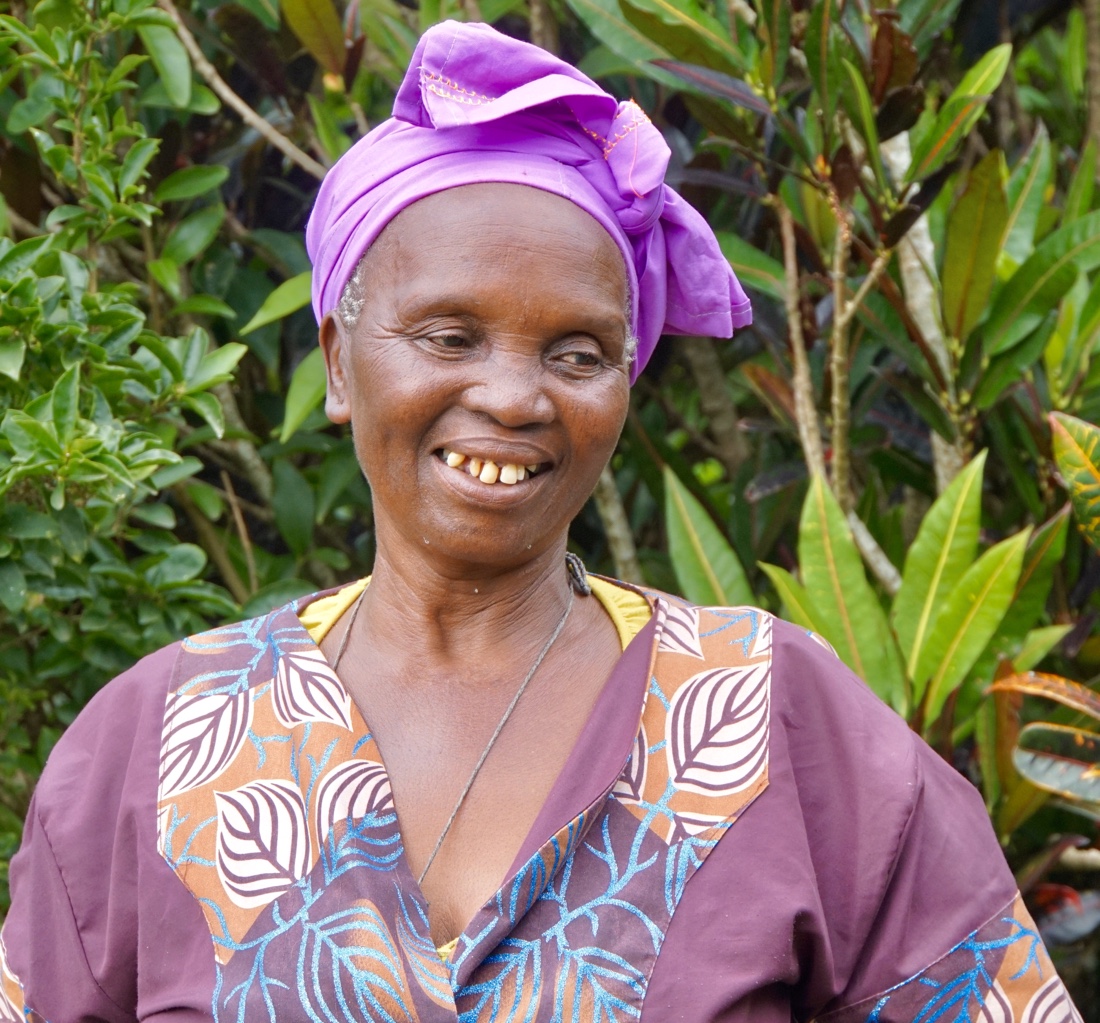 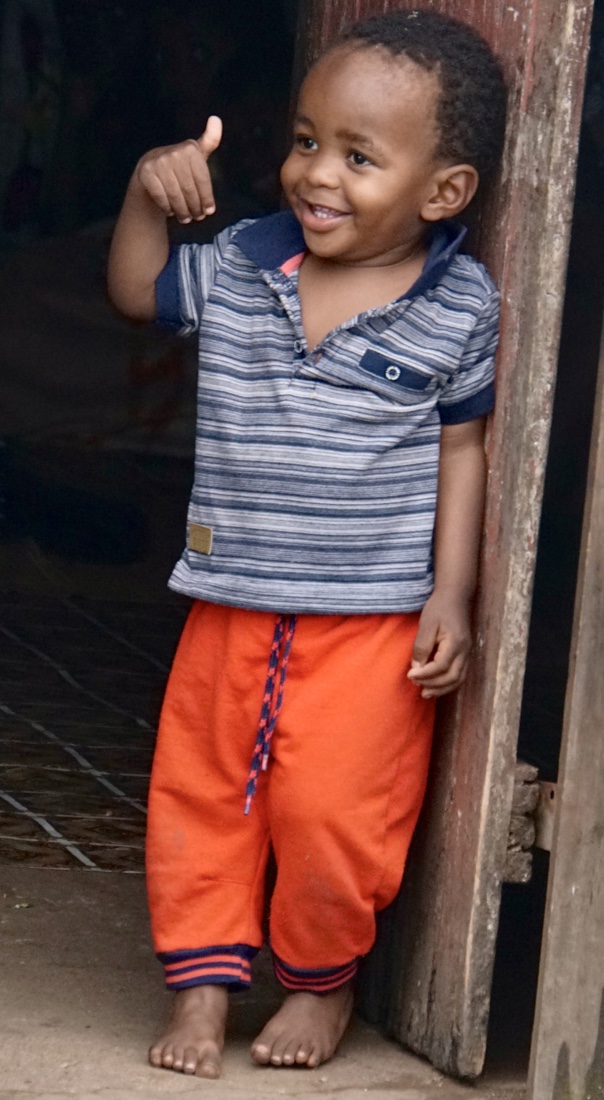
Late in the day we continue to Port Edward, where we stay at the quite nice Estuary Hotel & Spa.
April 6.
This morning we visit the Ebuhleni ba Manazaretha Shembe Church. It looks like rain, but it appears to us to be a huge crowd of about 1000 people, seated on mats in a grove of trees, barefoot and dressed in robes to hear and participate actively in the service led by a major Shembe leader, Umvangeli. People we talk to say that the attendance is 1/4 or 1/10 of what it would normally be because of the threat of rain.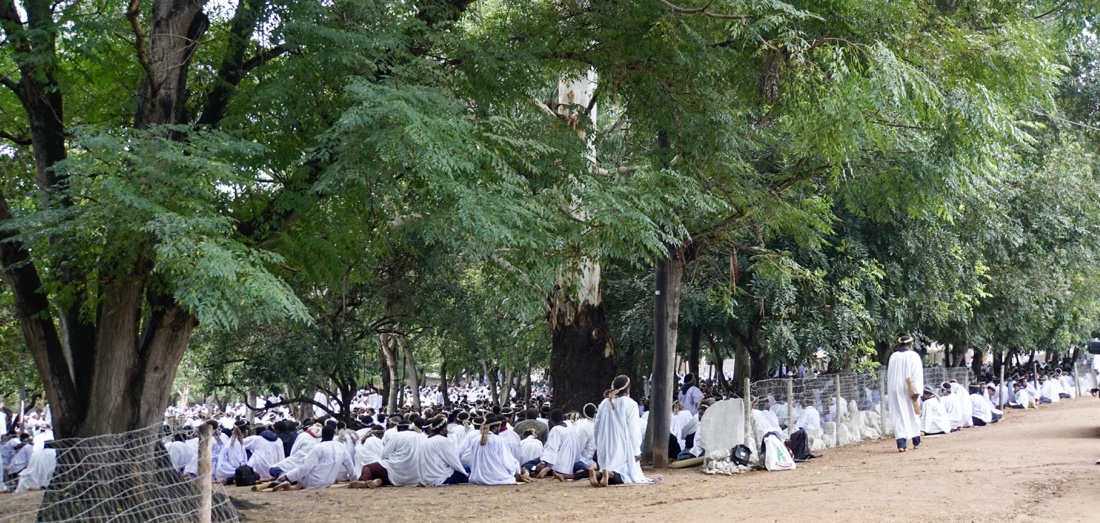 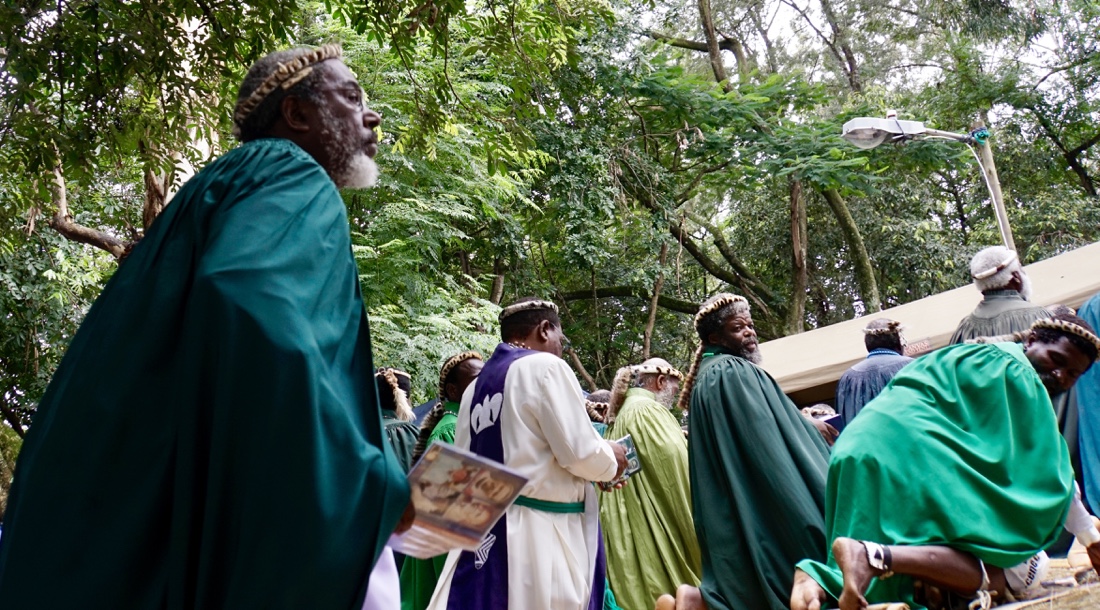 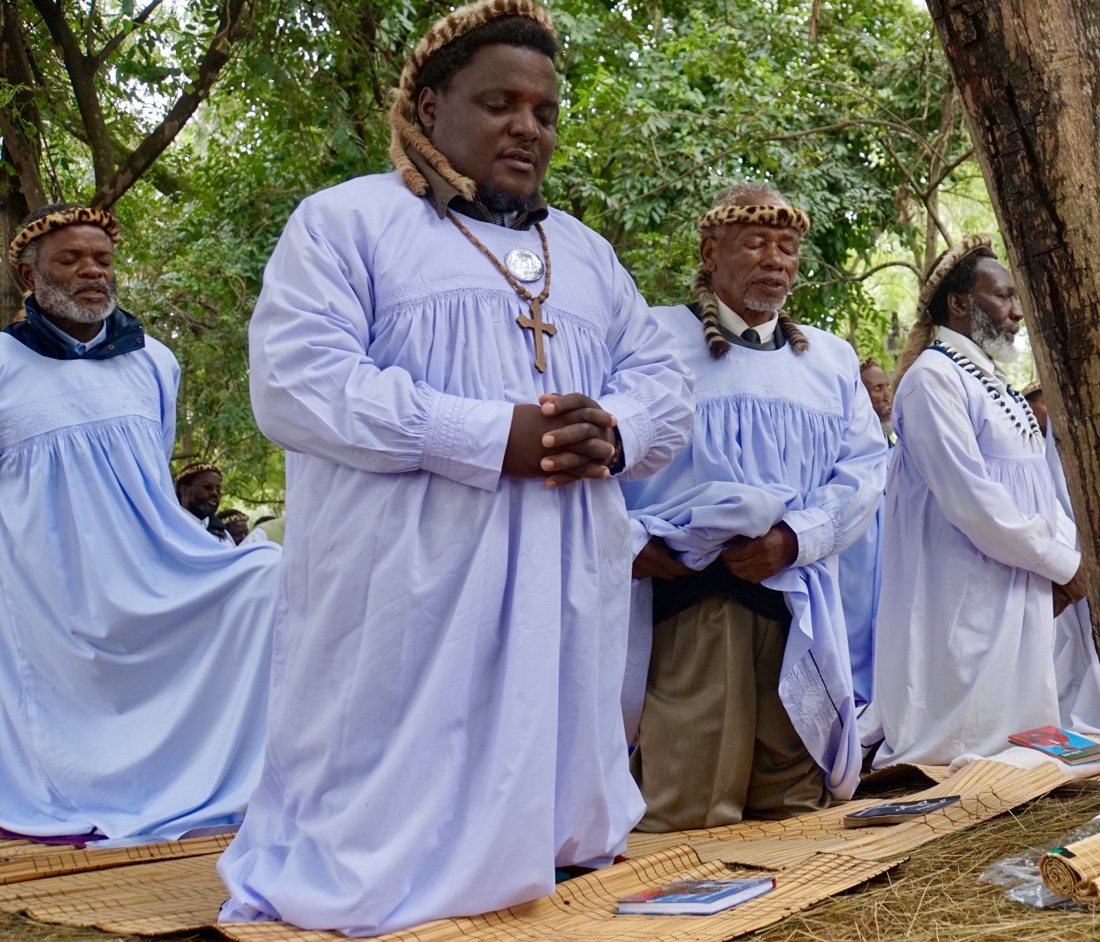
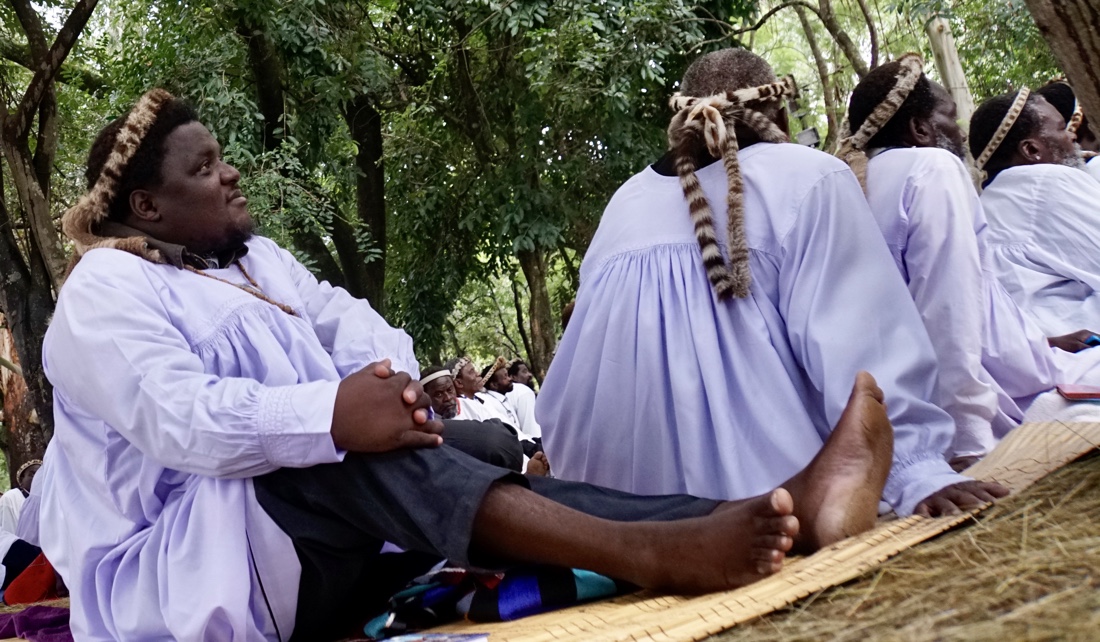 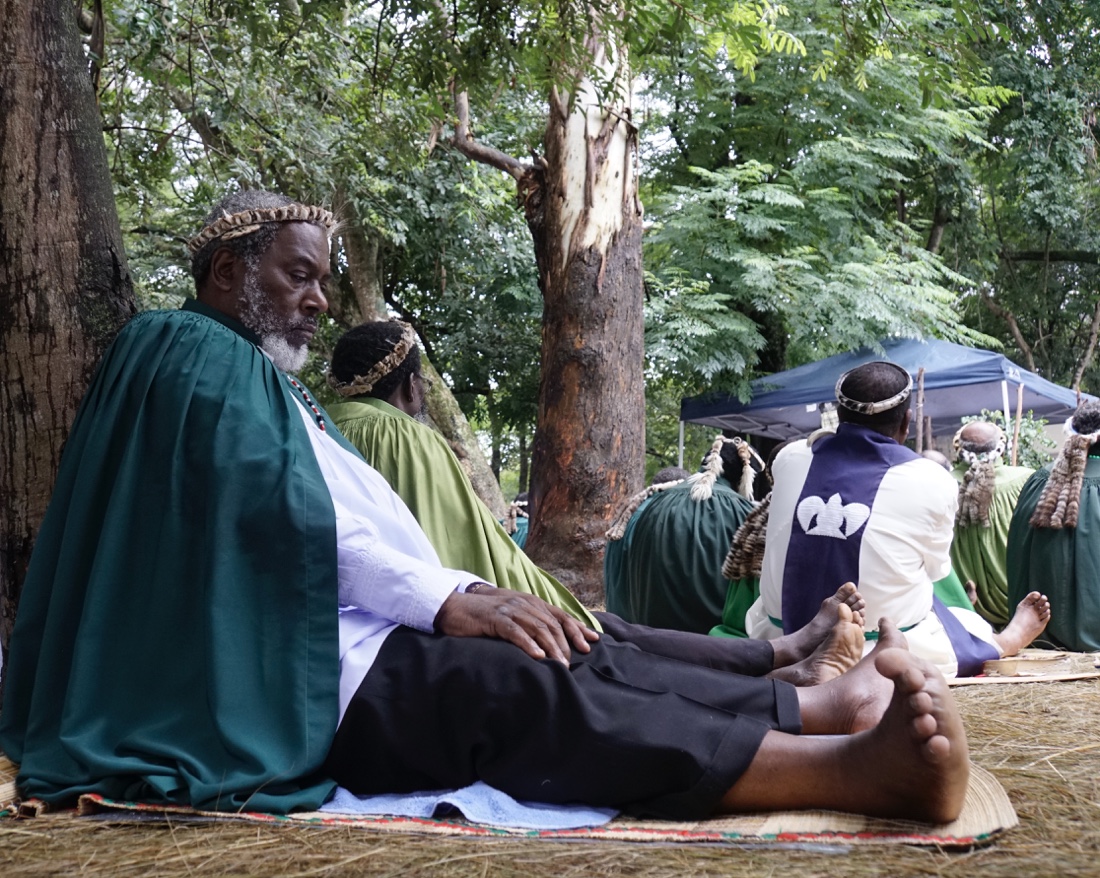 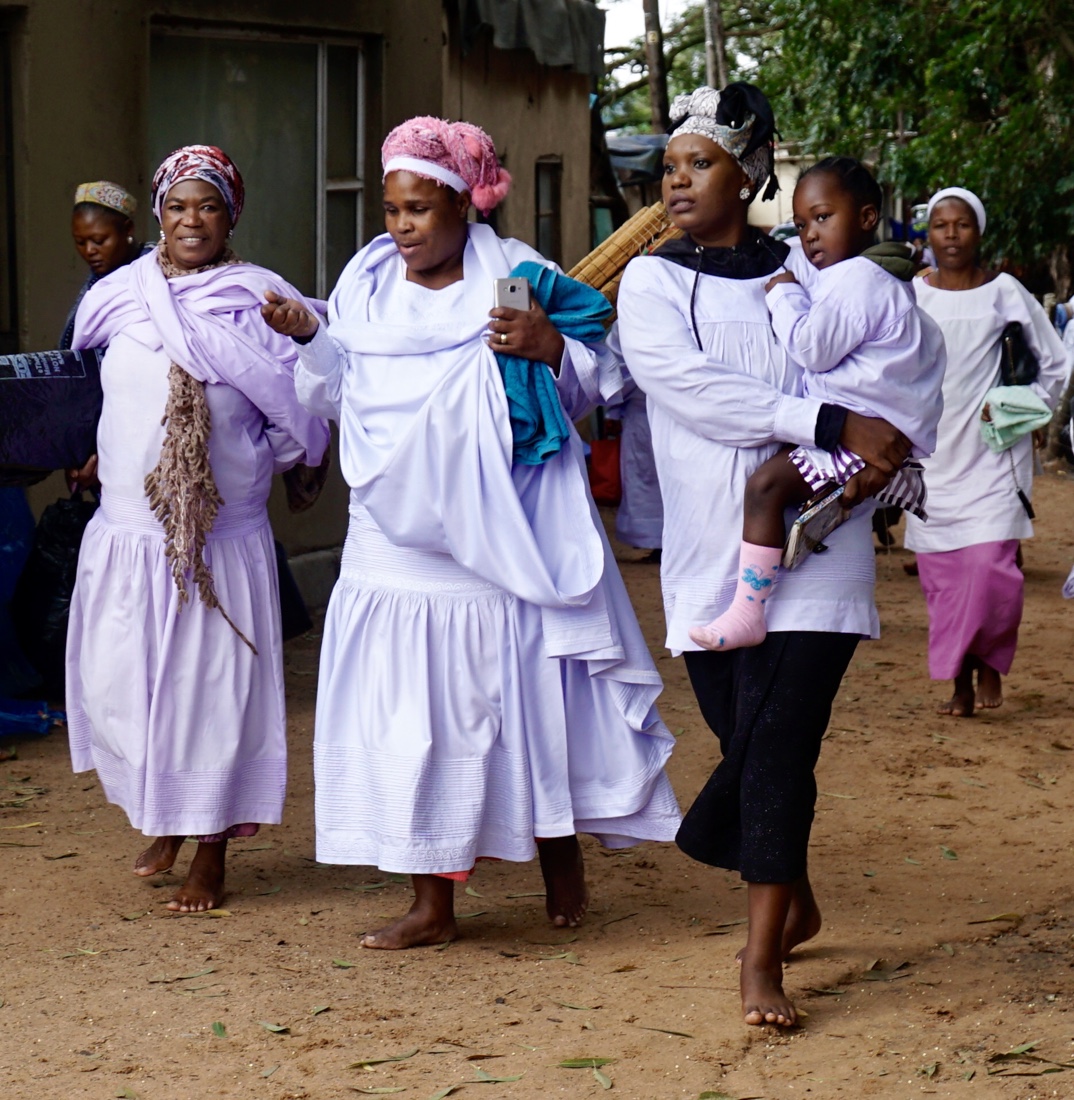 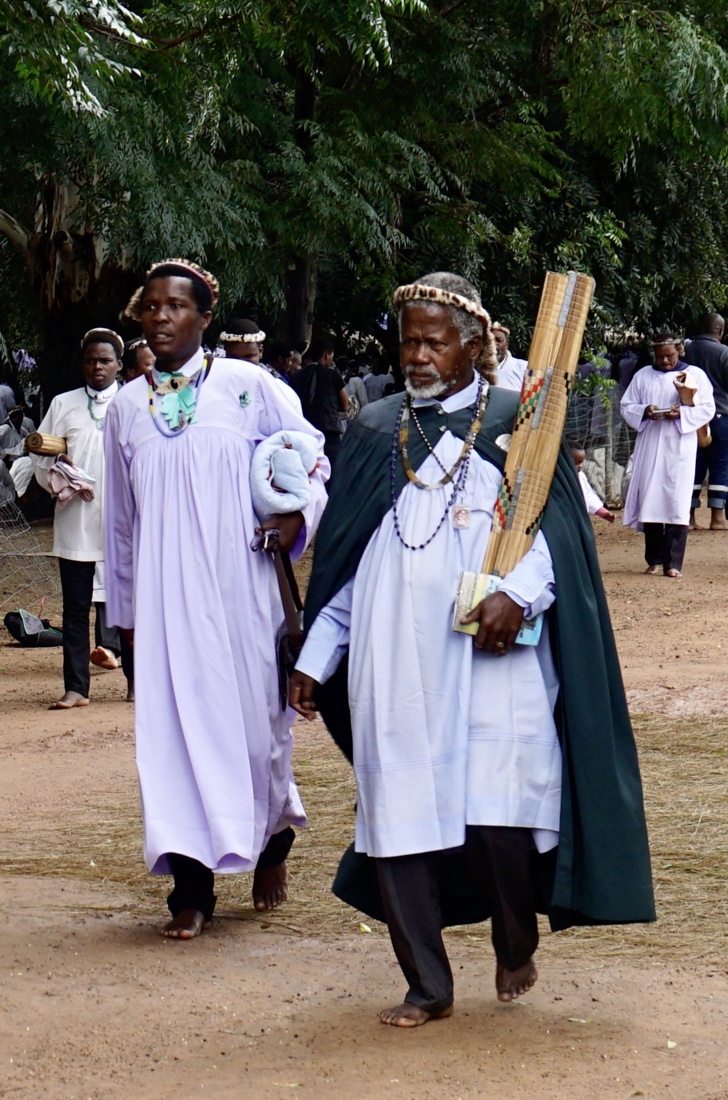 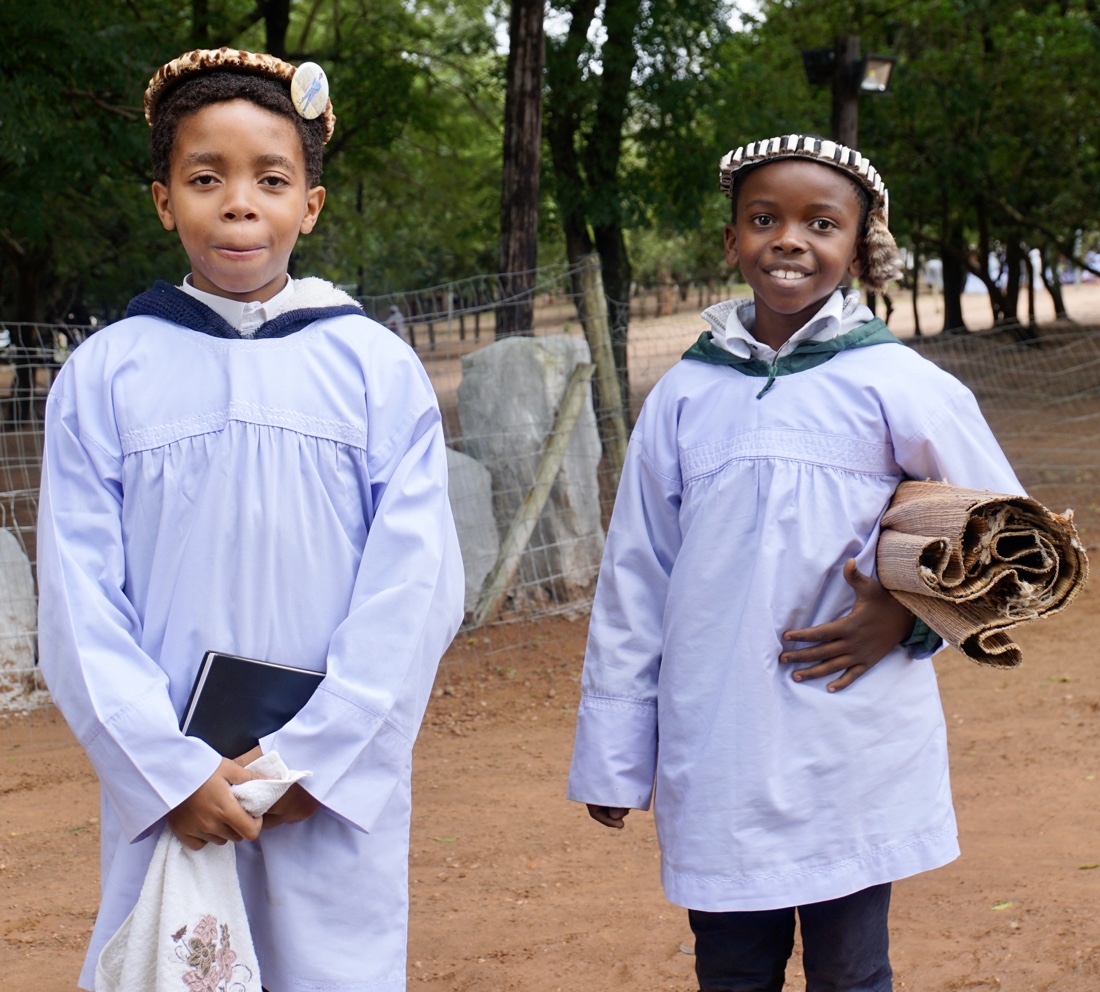 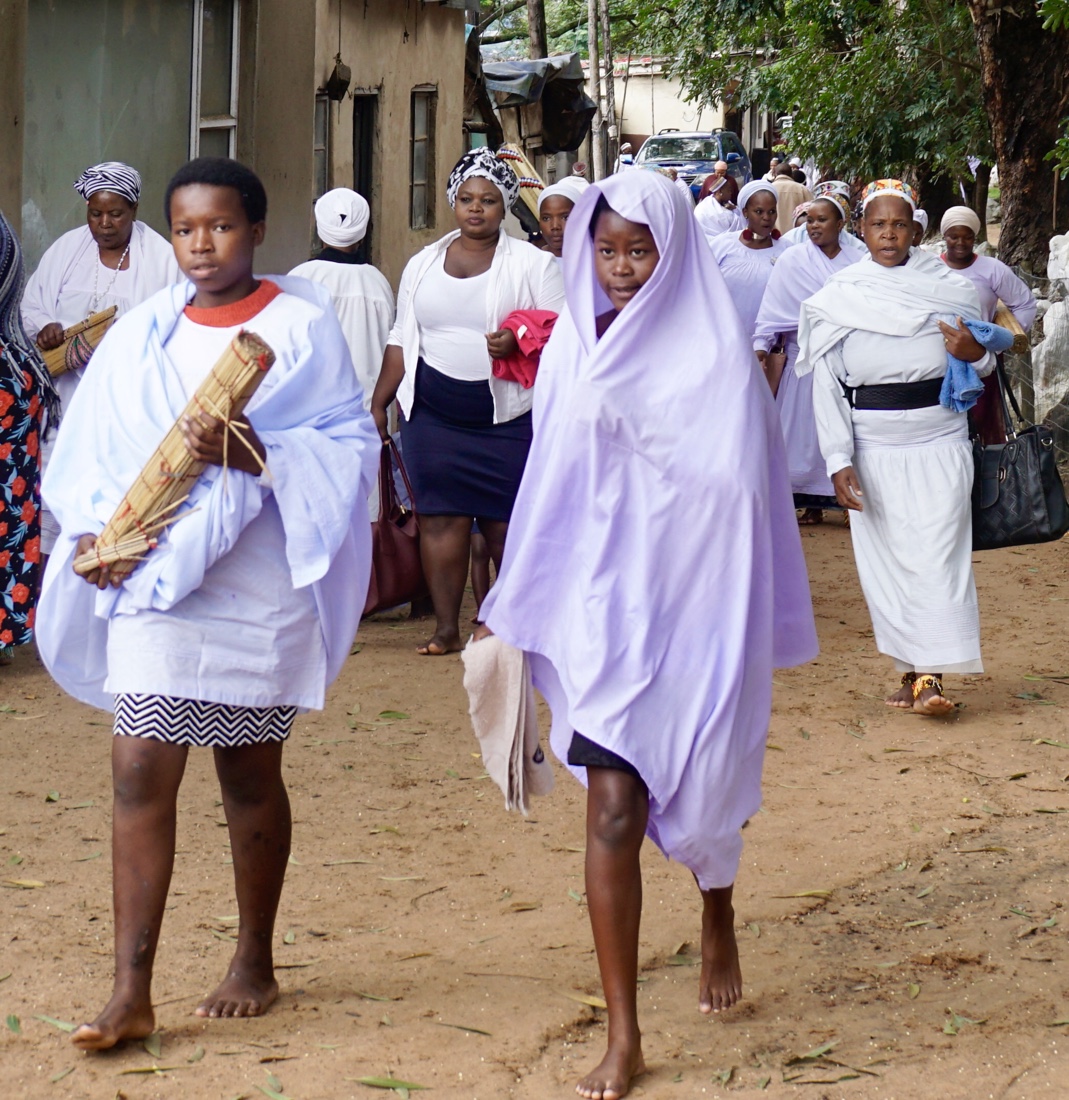 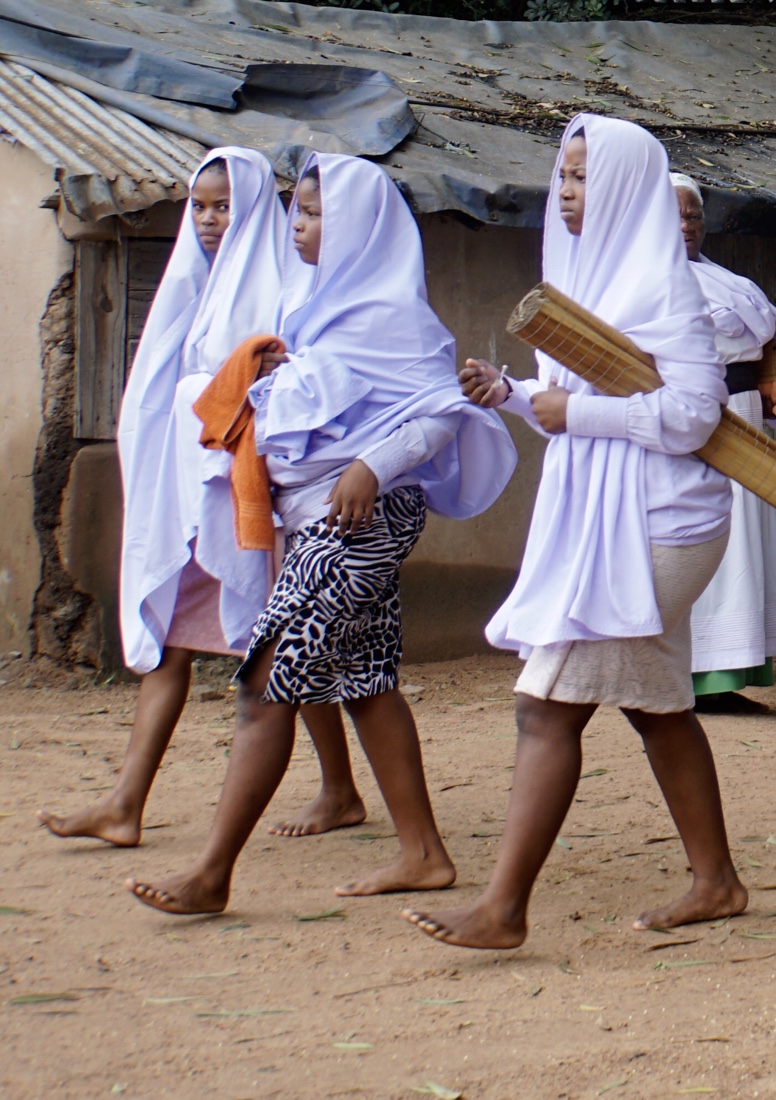 The Shembe Religion was founded by Isaiah Mloyiswa Mdliwamafa Shembe (c.1865– 2 May 1935) and was the largest African-initiated church in Africa during his lifetime. A self-styled prophet who claimed to have been sent directly by God, Shembe started his religious career as an itinerant evangelist and faith healer in 1910. Within ten years he had built up a large following in Natal with dozens of congregations across the province. Although the Nazarites were eventually eclipsed in size by several other Zionist Churches, the Nazarite church eventually had well over one million members before it began to splinter into competing groups in the 1980s. The Shembe Religion was founded by Isaiah Mloyiswa Mdliwamafa Shembe (c.1865– 2 May 1935) and was the largest African-initiated church in Africa during his lifetime. A self-styled prophet who claimed to have been sent directly by God, Shembe started his religious career as an itinerant evangelist and faith healer in 1910. Within ten years he had built up a large following in Natal with dozens of congregations across the province. Although the Nazarites were eventually eclipsed in size by several other Zionist Churches, the Nazarite church eventually had well over one million members before it began to splinter into competing groups in the 1980s.
After the Shembe service (about an hour and a half), we drove over to see the impressive shark-shaped stadium and then down to the beach to see large sand castles, skate boarders, young ladies posing for photos and people just hanging out on the beach.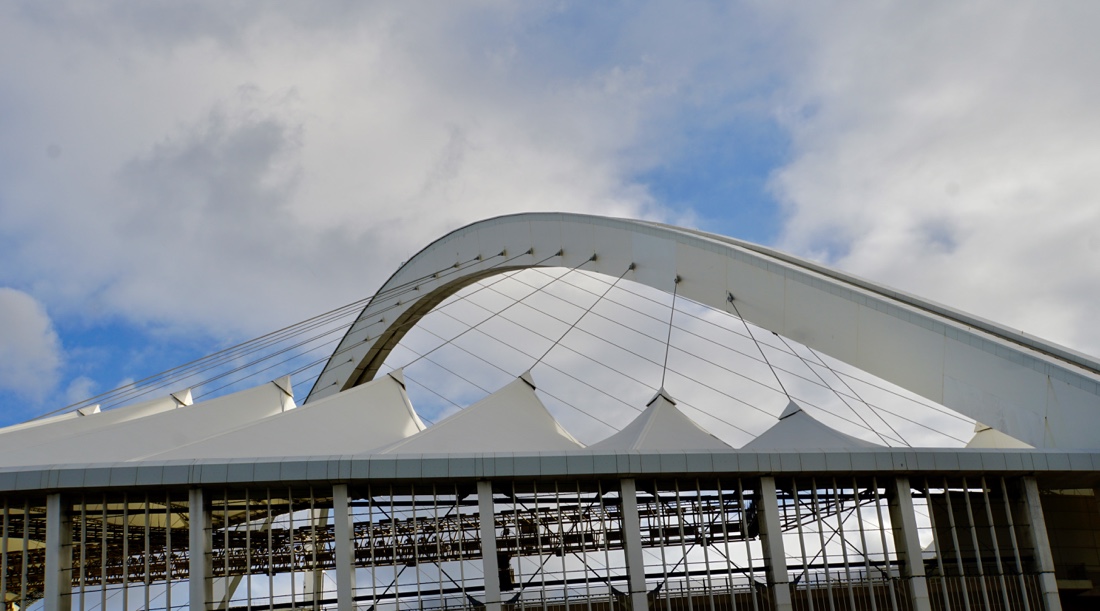 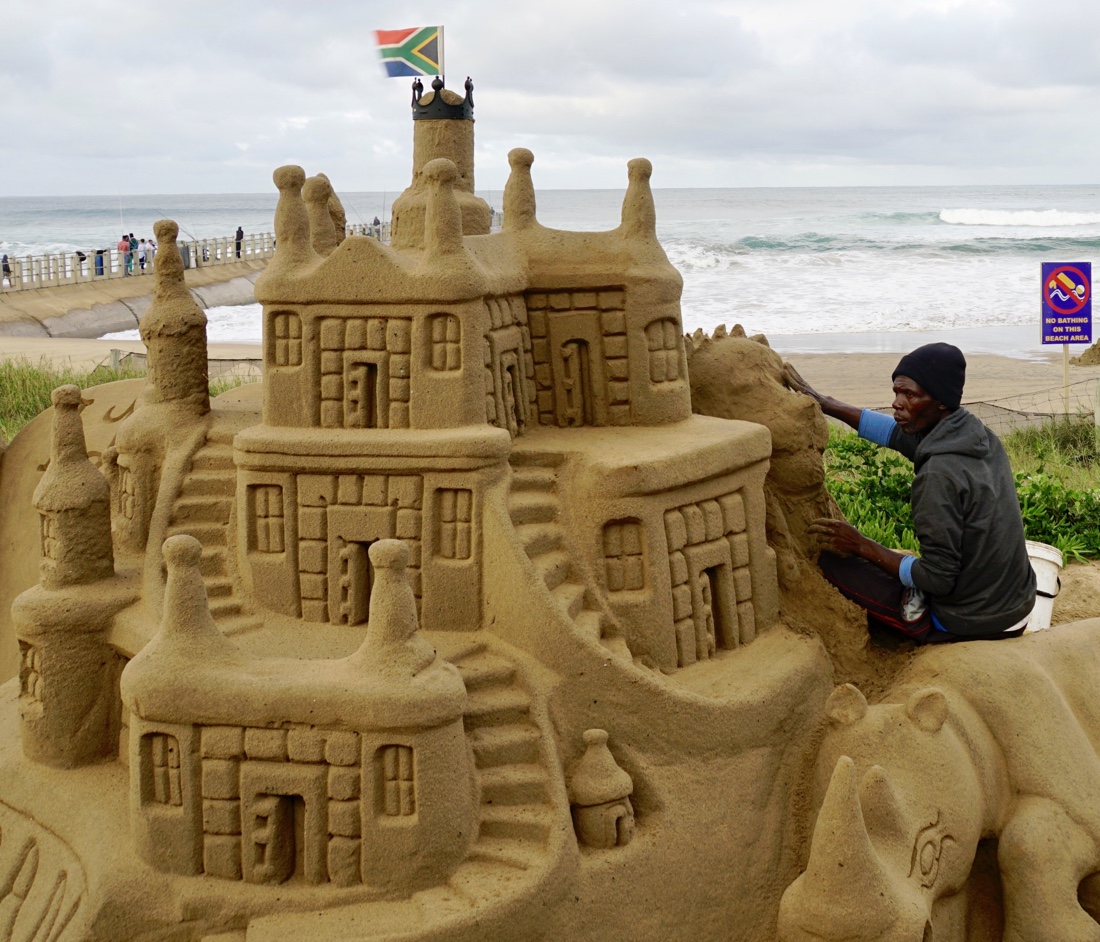 
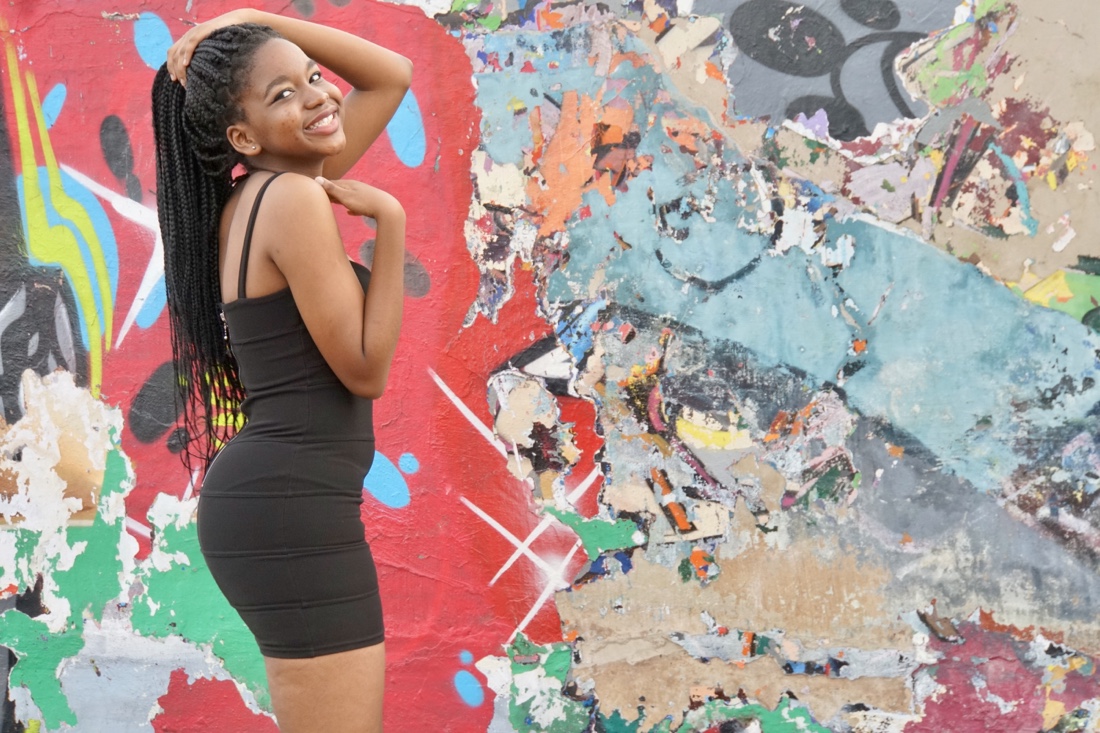 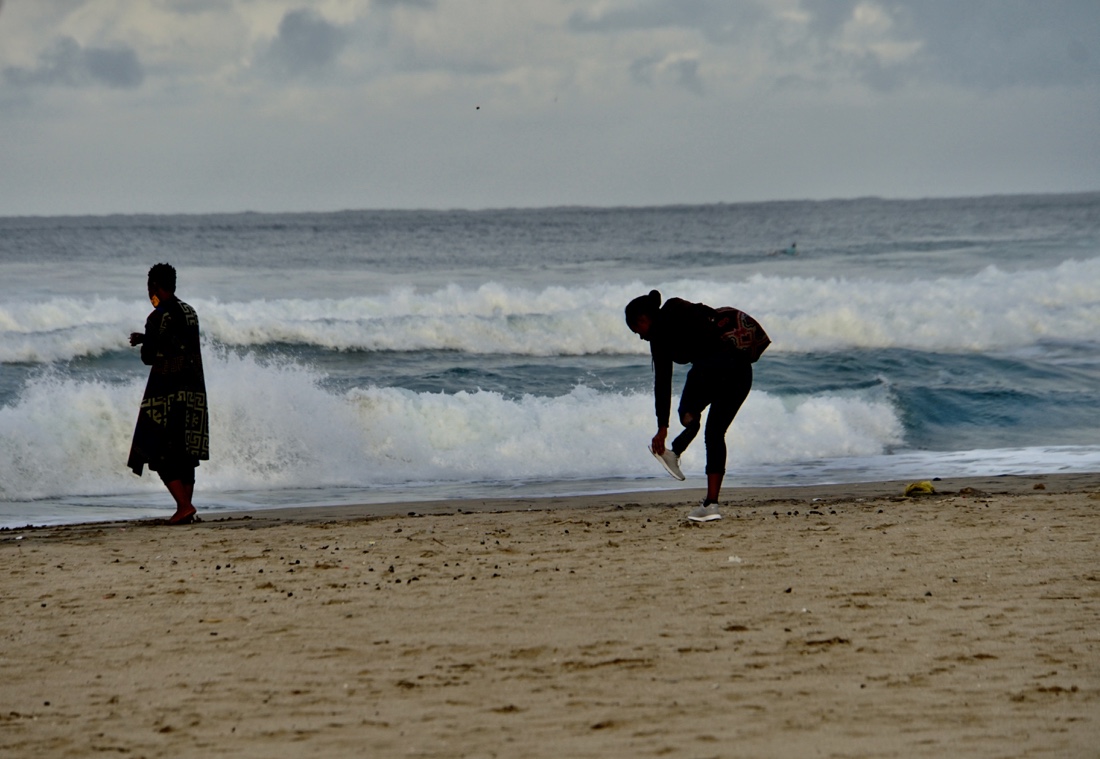 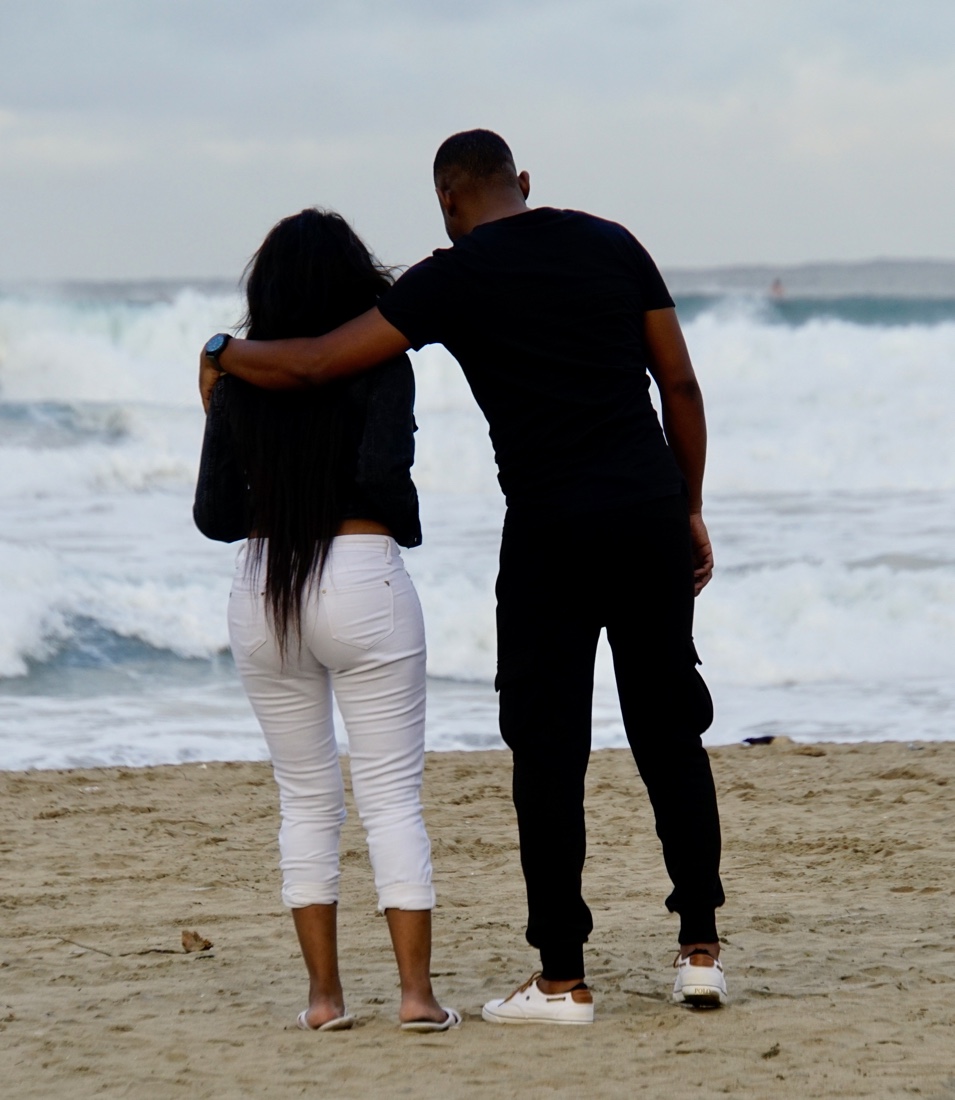 While many people may not be aware of this fact, Durban has the highest concentration of Indians outside of India. Indians from north and south India first began arriving in the Port of Natal from India in 1860. Unlike East Africa, where almost none of the emigrants took to agriculture, in South Africa indentured labor was primarily provided for agriculture and as servants, cooks, watchmen and builders at the Natal-Transvaal Railways. There were two waves of Indian emigration to South Africa; the first being indentured labor brought by the British to work in the sugar cane fields of Natal, and the second was in the form of paid passengers, who were mainly Gujarati Muslim and Hindu businessmen traveling to Africa. Indentured labor, a modern form of slavery tied a worker to an employer by contract (usually for five years) in return for wages and the cost of passage. After 1917, the majority of the laborers stayed back and became land owners on Durban’s east coast and diversified into other fields. By the 1940s, the next generation became the backbone of the emerging industrial working class in KwaZulu- Natal. While many people may not be aware of this fact, Durban has the highest concentration of Indians outside of India. Indians from north and south India first began arriving in the Port of Natal from India in 1860. Unlike East Africa, where almost none of the emigrants took to agriculture, in South Africa indentured labor was primarily provided for agriculture and as servants, cooks, watchmen and builders at the Natal-Transvaal Railways. There were two waves of Indian emigration to South Africa; the first being indentured labor brought by the British to work in the sugar cane fields of Natal, and the second was in the form of paid passengers, who were mainly Gujarati Muslim and Hindu businessmen traveling to Africa. Indentured labor, a modern form of slavery tied a worker to an employer by contract (usually for five years) in return for wages and the cost of passage. After 1917, the majority of the laborers stayed back and became land owners on Durban’s east coast and diversified into other fields. By the 1940s, the next generation became the backbone of the emerging industrial working class in KwaZulu- Natal.
By 1936 there were 219,925 Indians in South Africa, half of whom were born in the country. Mahatma Gandhi, who arrived in 1893 as a lawyer, played an integral role in South Africa’s political transformation. He was part of the formation of a unified Indian identity and in 1894 he formed South Africa’s first Indian political organization, the Natal Indian Congress (NIC).
Indians were considered non-whites during apartheid and thus they also felt the effects of stringent rules put in place against all black persons. They were forcibly moved into Indian townships, they could not enter certain stores, use particular beaches, marry outside their race and even walk on some roads.
Today Indians make up about 2.5% of the population in South Africa and have contributed to not only the diversity of the country but also the economy. A number of prominent Indian South Africans have emerged from the east coast including previous South African cricket captain, Hashim Amla and political activist Kader Asmal. Local food in Durban, including the iconic “bunny chow”, has been created by Indian people and many famous curry spots in Durban are run by Indians. Indians also runs a large number of businesses in Durban and can still be found in former Indian areas like Phoenix, Chatsworth and Overport.
In a tip of the hat to,the Indian population, we enjoyed a terrific Indian dinner.
April 5.
Well, I got screwed up because of WiFi problems, so these next posts will be a couple days late. But that shouldn’t matter to you.
After breakfast, we take a very harrowing, steep downhill road trip in dense fog, the terrain alternating between rocks and pot holes, and slippery mud, that’s like driving on snow or ice. Not fun. Compare this “view” with those in my prior posts.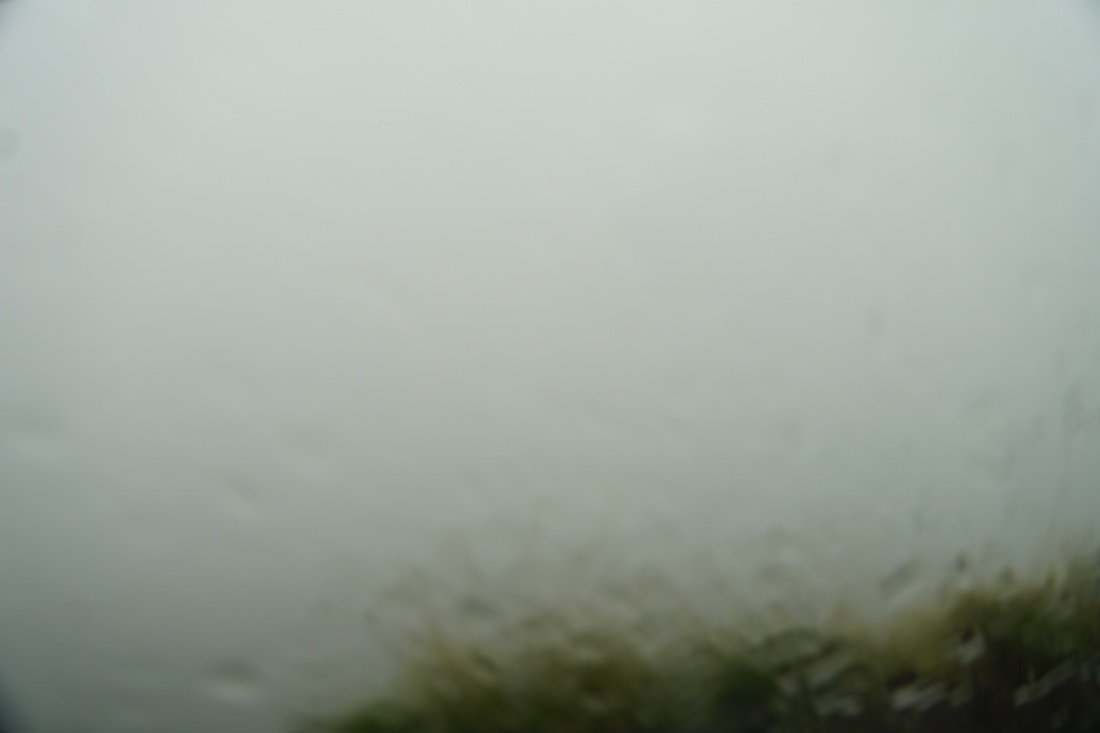
We arrive back into South Africa, say goodbye to our excellent Lesotho guide, Frank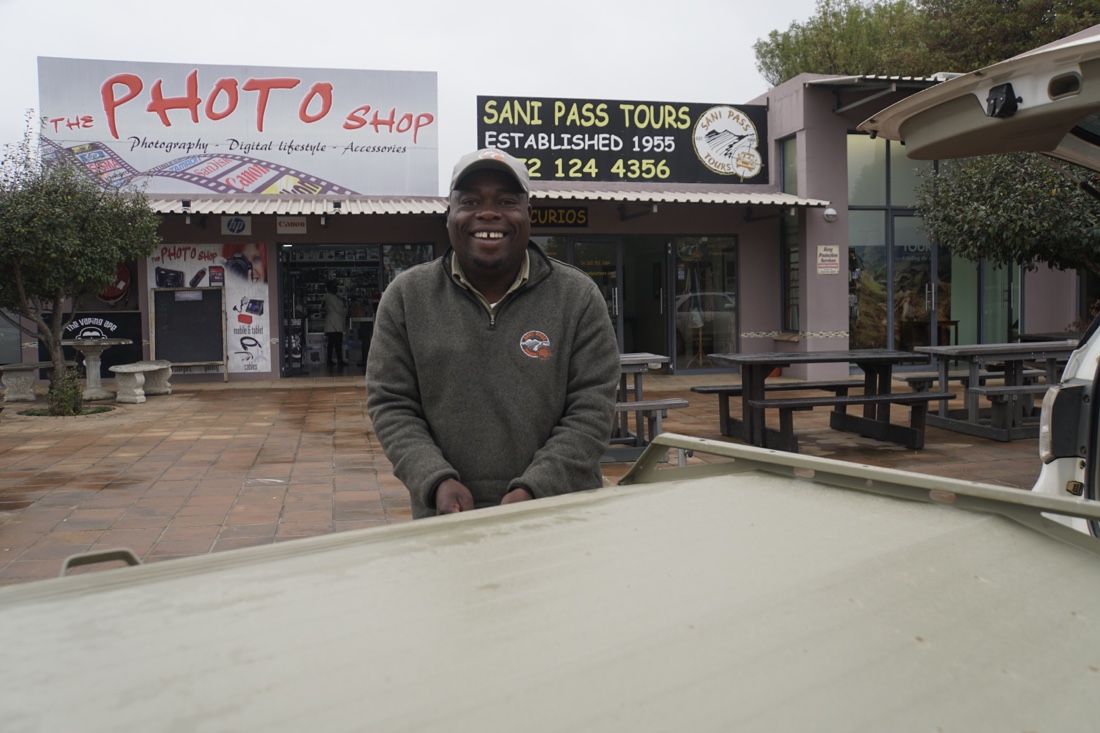 and reunite with our South Africa guide, Ndoda, in Underberg (a dairy and cattle farming community), passing through the Natal Midlands and onto Durban. We stop at the Nelson Mandela’s Capture Site outside Howick, which is fascinating. You walk down a long, brick path (in a light rain, in our case) towards what appears to be a cluster of twenty-seven metal poles, one for each year Mandela spent in prison. Along the sides of the path are metal plaques highlighting important events in Mandela’s life. and reunite with our South Africa guide, Ndoda, in Underberg (a dairy and cattle farming community), passing through the Natal Midlands and onto Durban. We stop at the Nelson Mandela’s Capture Site outside Howick, which is fascinating. You walk down a long, brick path (in a light rain, in our case) towards what appears to be a cluster of twenty-seven metal poles, one for each year Mandela spent in prison. Along the sides of the path are metal plaques highlighting important events in Mandela’s life.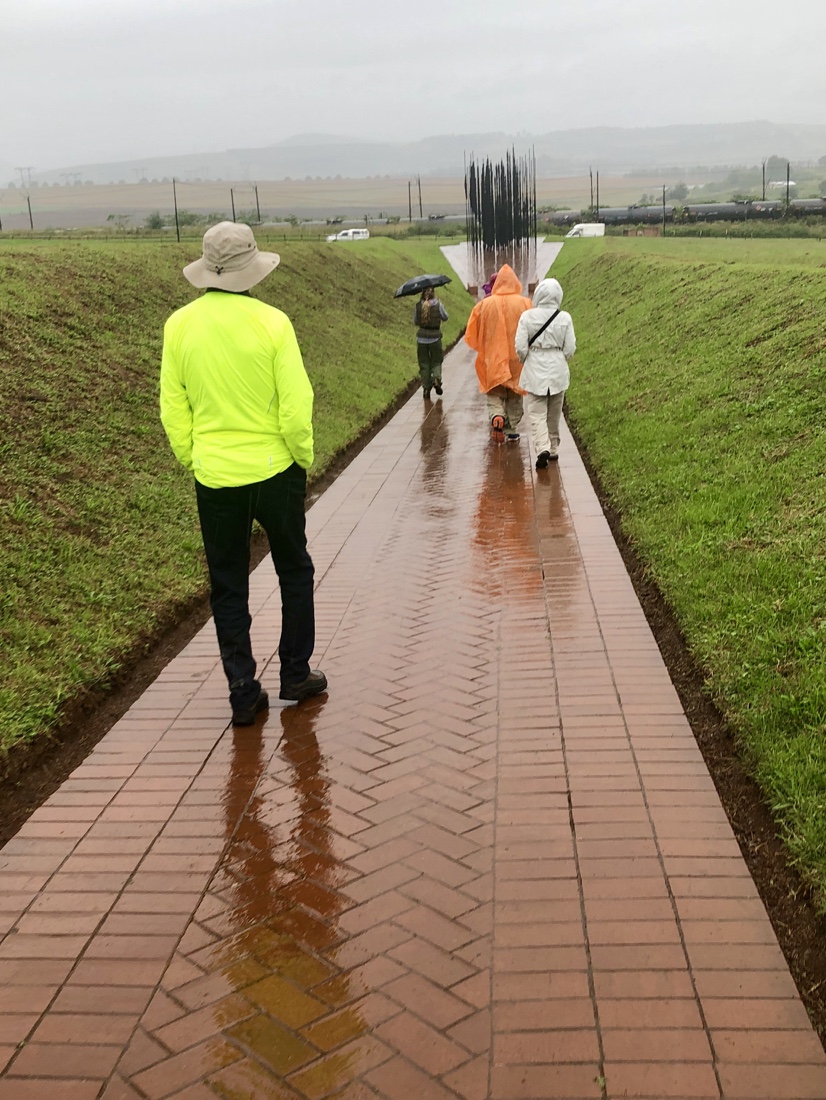 As you get closer to the poles, you see that they are not random, but reveal a portrait of Mandela. Very cool concept. As you get closer to the poles, you see that they are not random, but reveal a portrait of Mandela. Very cool concept.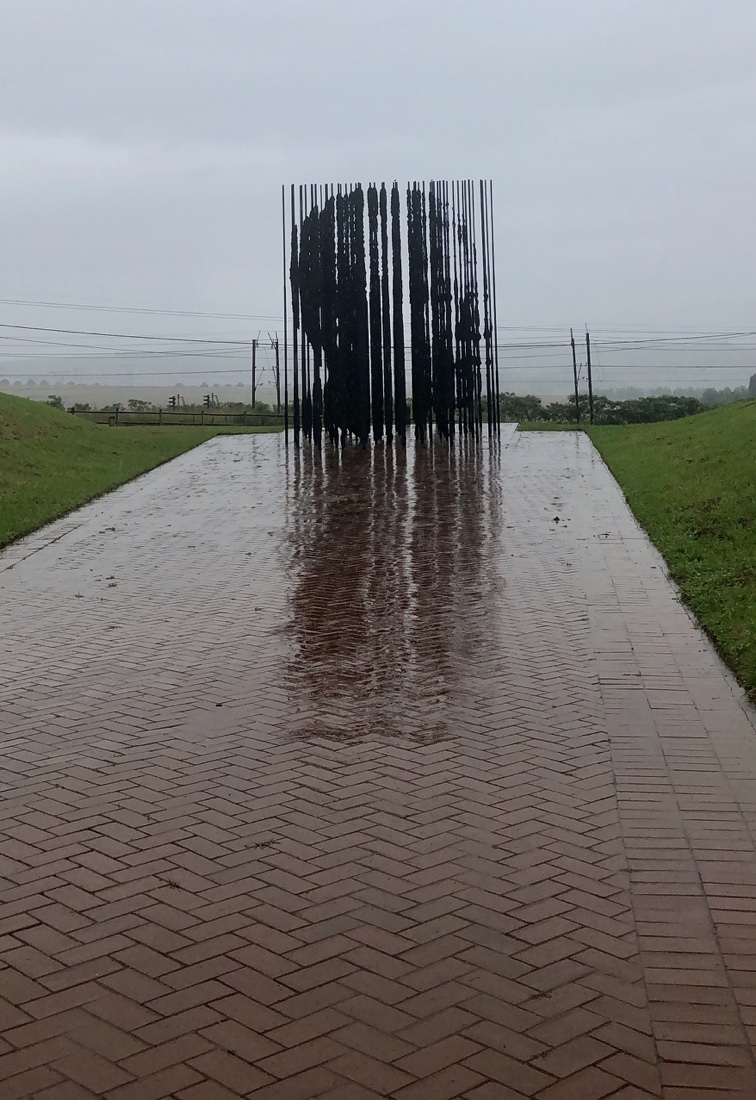
After the capture site, we drive about 15 minutes, at my suggestion, to see a wonderful ceramics gallery that Ndoda had mentioned. The Ardmore Gallery is situated on a lovely estate. The work is very unusual and of high-quality.  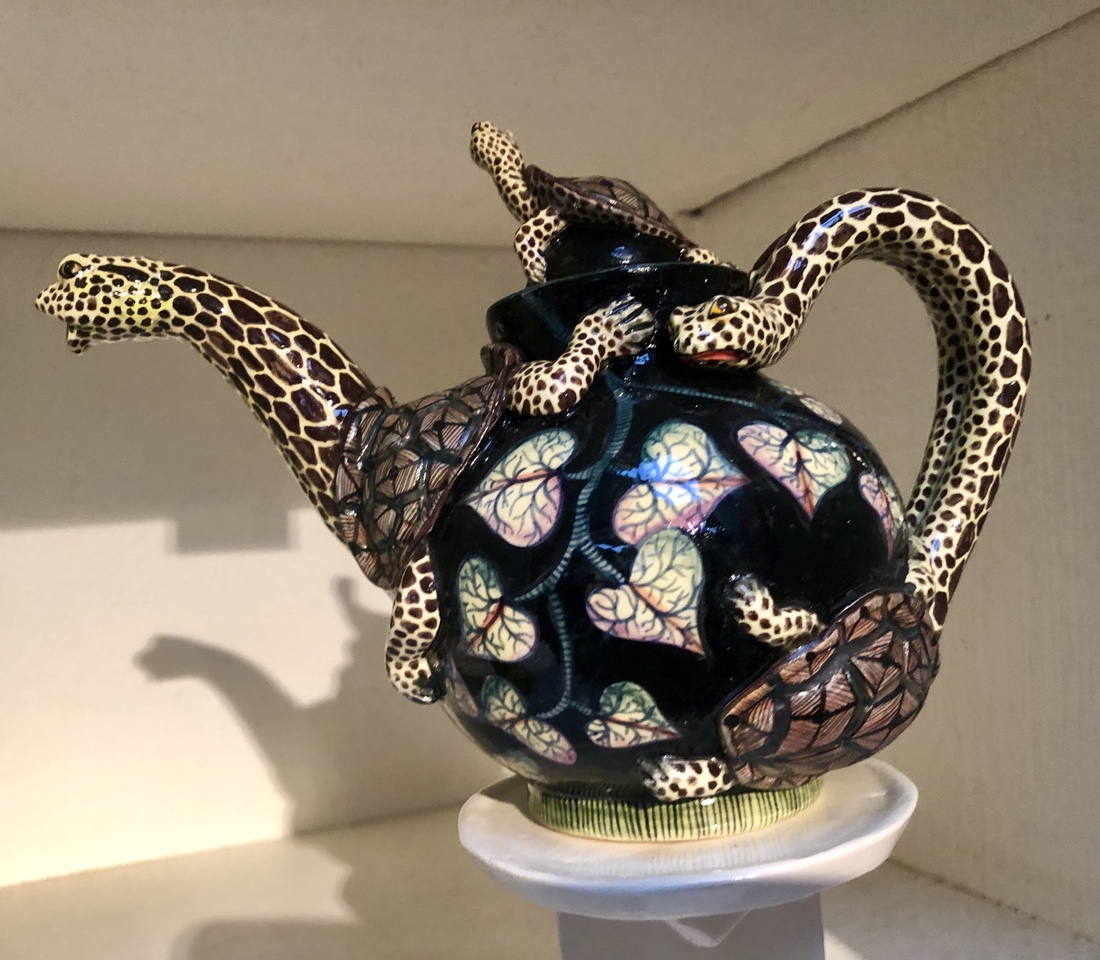 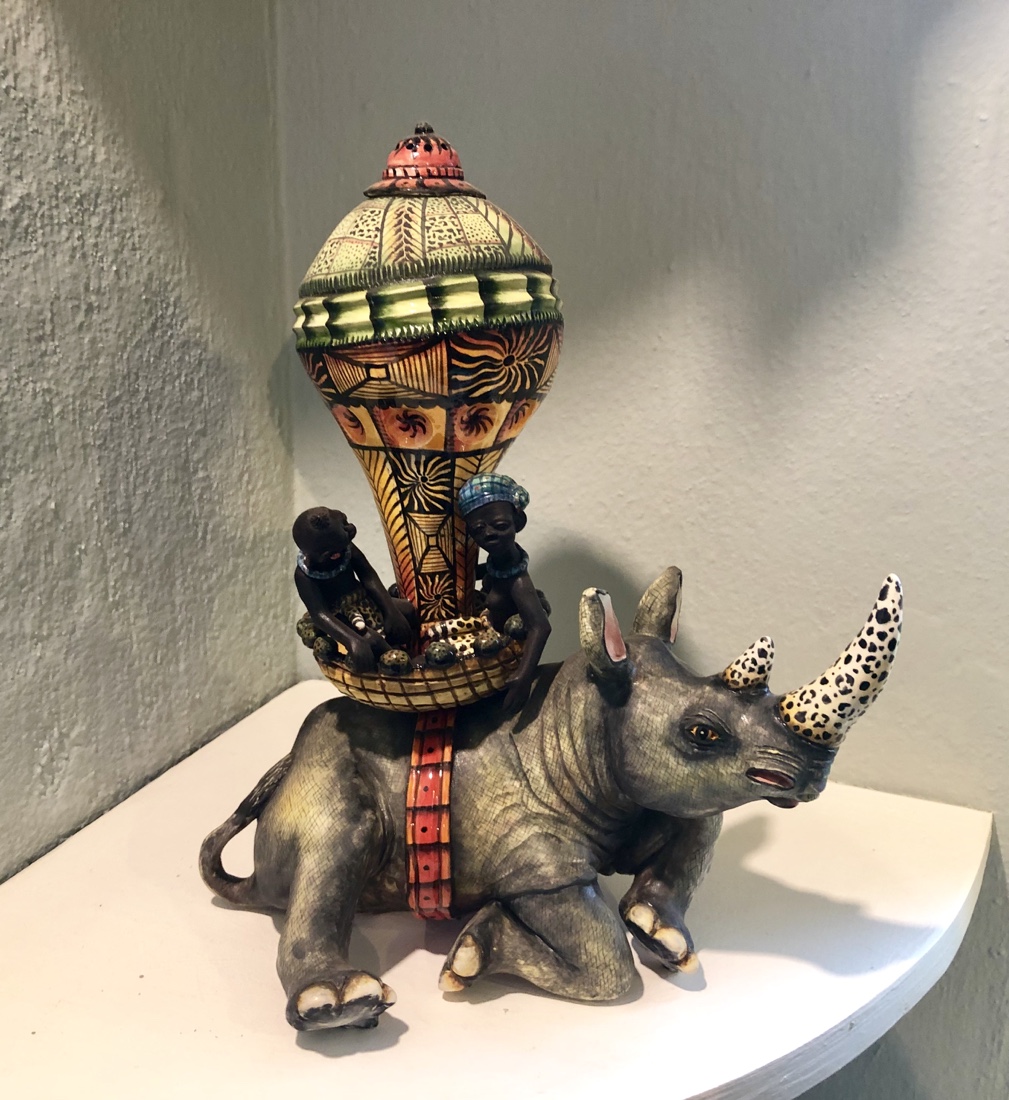
After walking through the gallery, we are able to see where the work is done. There is a group of more than 80 artists who work in teams of three on a piece. One person is the designer, a second does the ceramics and a third paints and fires the pieces. It’s interesting to see the people working on them. Afterwards, we return to the gallery and four members of the group purchase pieces. Because Carol is reading this blog, I can’t disclose whether I am one of them.
We arrive in Durban in the afternoon. Durban is South Africa’s third-largest city and Africa’s busiest port. The city enjoys a wonderful sub-tropical climate and warm swimming waters throughout the year. Founded in 1824 by the British who negotiated with the mighty Zulu King Shaka, authorizing them to establish a trading station. In 1835 the town was named in honor of Sir Benjamin D’Urban and was augmented by the arrival of indentured Indian labor to work on the sugar cane fields. The city echoes these diverse Zulu, Colonial and Indian cultures in both its architecture and atmosphere and buildings reflect an interesting mix of Art Deco, Victorian, Indian and Zulu influences.
We have dinner at a very funky restaurant, each room decorated differently. An open area in the center would be available for dancing, were it not raining.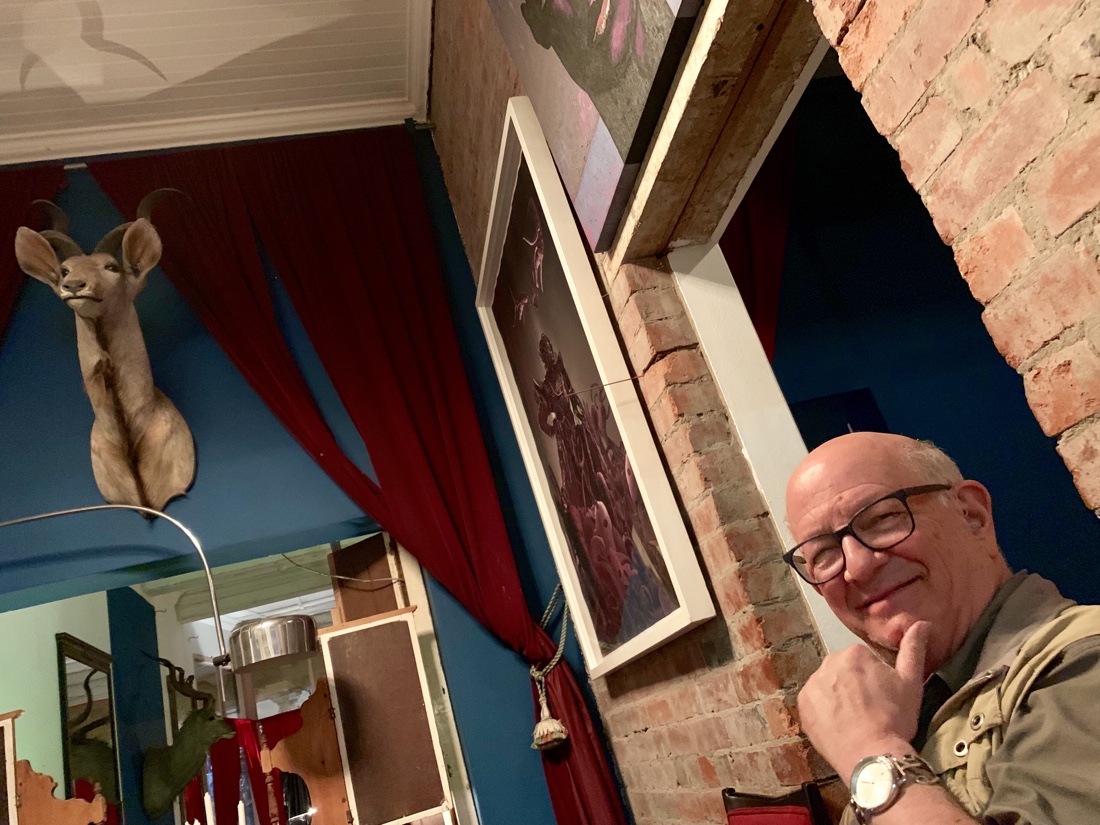
We stay at a very upscale B&B, the Goble Palms Guest House.
|
|






 We walk into some shops and have lunch in Joburg’s most recent modern, called Victoria Square, built around a former industrial area.
We walk into some shops and have lunch in Joburg’s most recent modern, called Victoria Square, built around a former industrial area. and then drive through Soweto, a township of some four million people, whose history is intimately involved with apartheid in South Africa. We drive down one street that is the only street in the world on which two Nobel Peace Laureates lived, Nelson Mandela and Bishop Desmond Tutu. While some of the areas of Soweto are now well-to-do and rather upscale, most of it reflects the image that people have of the area.
and then drive through Soweto, a township of some four million people, whose history is intimately involved with apartheid in South Africa. We drive down one street that is the only street in the world on which two Nobel Peace Laureates lived, Nelson Mandela and Bishop Desmond Tutu. While some of the areas of Soweto are now well-to-do and rather upscale, most of it reflects the image that people have of the area. 




 Prior to the dinner, I read the “real South African blog,” to the group which takes a light look at what transpired on the trip. The “real blog” is well received.
Prior to the dinner, I read the “real South African blog,” to the group which takes a light look at what transpired on the trip. The “real blog” is well received.



 We return to the hotel for a quick breakfast and then head south, past Port Shepstone to another Zulu community in the foothills of the Ntantana Mountain overlooking both the Nyandezulu Waterfall and the sea. Dudu Malinga welcomes us into her home where she lives with her daughter, grandchild and nephew in a rural Zulu Village.
We return to the hotel for a quick breakfast and then head south, past Port Shepstone to another Zulu community in the foothills of the Ntantana Mountain overlooking both the Nyandezulu Waterfall and the sea. Dudu Malinga welcomes us into her home where she lives with her daughter, grandchild and nephew in a rural Zulu Village. Sangomas are traditional healers of South Africa, practitioners of traditional African medicine. They fulfill different social and political roles in the community, including divination, healing physical, emotional and spiritual illnesses, directing birth or death rituals, finding lost cattle, protecting warriors, counteracting witchcraft, and narrating the history, cosmology, and myths of their tradition.
Sangomas are traditional healers of South Africa, practitioners of traditional African medicine. They fulfill different social and political roles in the community, including divination, healing physical, emotional and spiritual illnesses, directing birth or death rituals, finding lost cattle, protecting warriors, counteracting witchcraft, and narrating the history, cosmology, and myths of their tradition.














 The Shembe Religion was founded by Isaiah Mloyiswa Mdliwamafa Shembe (c.1865– 2 May 1935) and was the largest African-initiated church in Africa during his lifetime. A self-styled prophet who claimed to have been sent directly by God, Shembe started his religious career as an itinerant evangelist and faith healer in 1910. Within ten years he had built up a large following in Natal with dozens of congregations across the province. Although the Nazarites were eventually eclipsed in size by several other Zionist Churches, the Nazarite church eventually had well over one million members before it began to splinter into competing groups in the 1980s.
The Shembe Religion was founded by Isaiah Mloyiswa Mdliwamafa Shembe (c.1865– 2 May 1935) and was the largest African-initiated church in Africa during his lifetime. A self-styled prophet who claimed to have been sent directly by God, Shembe started his religious career as an itinerant evangelist and faith healer in 1910. Within ten years he had built up a large following in Natal with dozens of congregations across the province. Although the Nazarites were eventually eclipsed in size by several other Zionist Churches, the Nazarite church eventually had well over one million members before it began to splinter into competing groups in the 1980s.




 While many people may not be aware of this fact, Durban has the highest concentration of Indians outside of India. Indians from north and south India first began arriving in the Port of Natal from India in 1860. Unlike East Africa, where almost none of the emigrants took to agriculture, in South Africa indentured labor was primarily provided for agriculture and as servants, cooks, watchmen and builders at the Natal-Transvaal Railways. There were two waves of Indian emigration to South Africa; the first being indentured labor brought by the British to work in the sugar cane fields of Natal, and the second was in the form of paid passengers, who were mainly Gujarati Muslim and Hindu businessmen traveling to Africa. Indentured labor, a modern form of slavery tied a worker to an employer by contract (usually for five years) in return for wages and the cost of passage. After 1917, the majority of the laborers stayed back and became land owners on Durban’s east coast and diversified into other fields. By the 1940s, the next generation became the backbone of the emerging industrial working class in KwaZulu- Natal.
While many people may not be aware of this fact, Durban has the highest concentration of Indians outside of India. Indians from north and south India first began arriving in the Port of Natal from India in 1860. Unlike East Africa, where almost none of the emigrants took to agriculture, in South Africa indentured labor was primarily provided for agriculture and as servants, cooks, watchmen and builders at the Natal-Transvaal Railways. There were two waves of Indian emigration to South Africa; the first being indentured labor brought by the British to work in the sugar cane fields of Natal, and the second was in the form of paid passengers, who were mainly Gujarati Muslim and Hindu businessmen traveling to Africa. Indentured labor, a modern form of slavery tied a worker to an employer by contract (usually for five years) in return for wages and the cost of passage. After 1917, the majority of the laborers stayed back and became land owners on Durban’s east coast and diversified into other fields. By the 1940s, the next generation became the backbone of the emerging industrial working class in KwaZulu- Natal.
 and reunite with our South Africa guide, Ndoda, in Underberg (a dairy and cattle farming community), passing through the Natal Midlands and onto Durban. We stop at the Nelson Mandela’s Capture Site outside Howick, which is fascinating. You walk down a long, brick path (in a light rain, in our case) towards what appears to be a cluster of twenty-seven metal poles, one for each year Mandela spent in prison. Along the sides of the path are metal plaques highlighting important events in Mandela’s life.
and reunite with our South Africa guide, Ndoda, in Underberg (a dairy and cattle farming community), passing through the Natal Midlands and onto Durban. We stop at the Nelson Mandela’s Capture Site outside Howick, which is fascinating. You walk down a long, brick path (in a light rain, in our case) towards what appears to be a cluster of twenty-seven metal poles, one for each year Mandela spent in prison. Along the sides of the path are metal plaques highlighting important events in Mandela’s life. As you get closer to the poles, you see that they are not random, but reveal a portrait of Mandela. Very cool concept.
As you get closer to the poles, you see that they are not random, but reveal a portrait of Mandela. Very cool concept.




